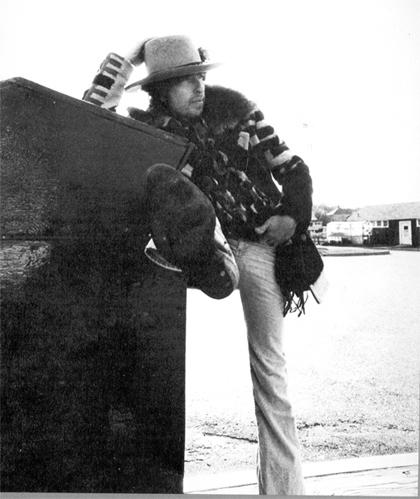 | |||
 | |||

|
Desire (released January 5, 1976) - Bob Dylan - Album Cover Photo Location - Plymouth Memorial Park, Plymouth, Massachusetts - October 31, 1975. Photo by Ken Regan, official photographer of the Rolling Thunder Revue tour. Desire, Dylan's 17th studio album, came between Blood on the Tracks (January, 1975) and Street Legal (June, 1978). It was recorded just before the Rolling Thunder tour and released in the middle of it. Wikipedia says: "Desire is one of Dylan's most collaborative efforts, featuring the same caravan of musicians as the acclaimed Rolling Thunder Revue ...Most of the album was co-written by Jacques Levy, and is composed of lengthy story-songs, two of which quickly generated controversy: the over-11-minute long "Joey", ...about the gangster "Crazy Joe" Gallo, and "Hurricane," a passionate account of the murder case against boxer Rubin Carter, whom the song asserts was framed. Carter was later released." Other songs on the album include "Isis," "One More Cup of Coffee," "Mozambique," "Oh, Sister," "Romance in Durango," Black Diamond Bay," and "Sara." The album cover can be seen below. In the picture, Dylan is wearing a light gray hat adorned with flowers, a black scarf with large tan spots on it, and a red, white, black, and orange Navajo-type coat. 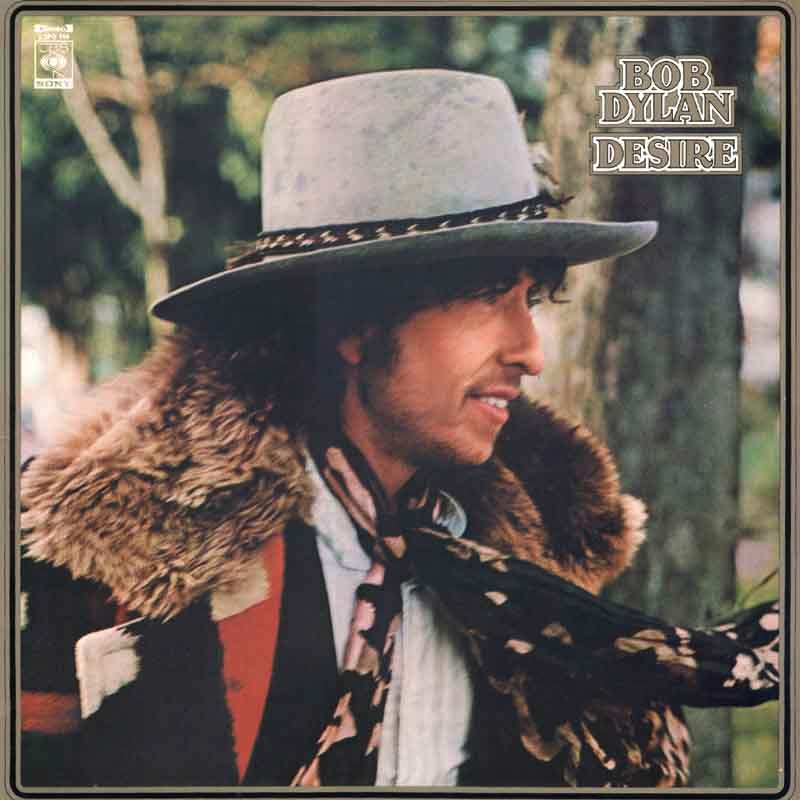
The album cover photo was taken in Plymouth, Massachusetts, during the opening days of Dylan's "Rolling Thunder Revue" tour in this small park (see photo below) by the water. It's called the Plymouth Memorial State Park. The park sits between two historic monuments: On one side is a historic replica of the Mayflower*, the boat on which the Pilgrims came to America from England in 1620. It is called the Mayflower II and can be seen in the right of the photo. (*The boat was built in Devon, England. It was sailed across the Atlantic in 1957 to be part of this state park.) On the other side of the park is an columned concrete pavilion covering Plymouth Rock, the large boulder on which it is said that the first settlers stood when they arrived. It is to the left in the picture. 
If we zoom into the middle of the park, we see a group of three trees. That's the general area where the pictures that became the album cover were taken in 1975. 
And here's the PopSpot of the scene. 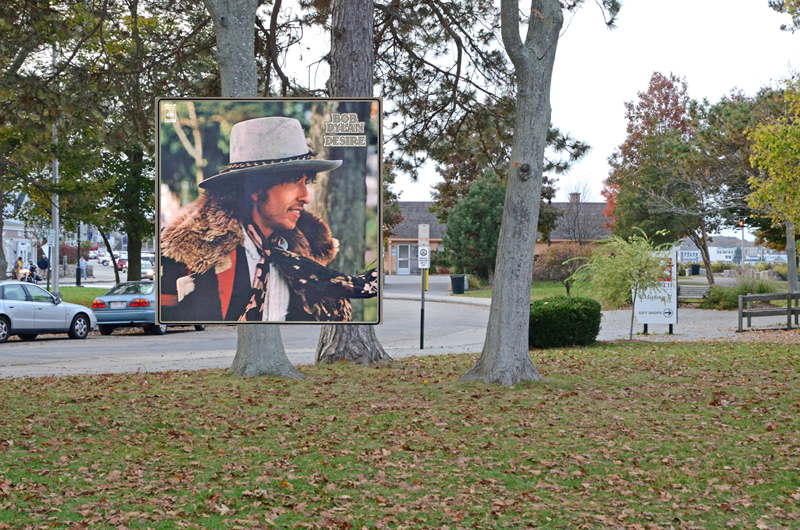
In this vintage Plymouth Rock, postcard the cover photo would have been taken along the path of the arrow. 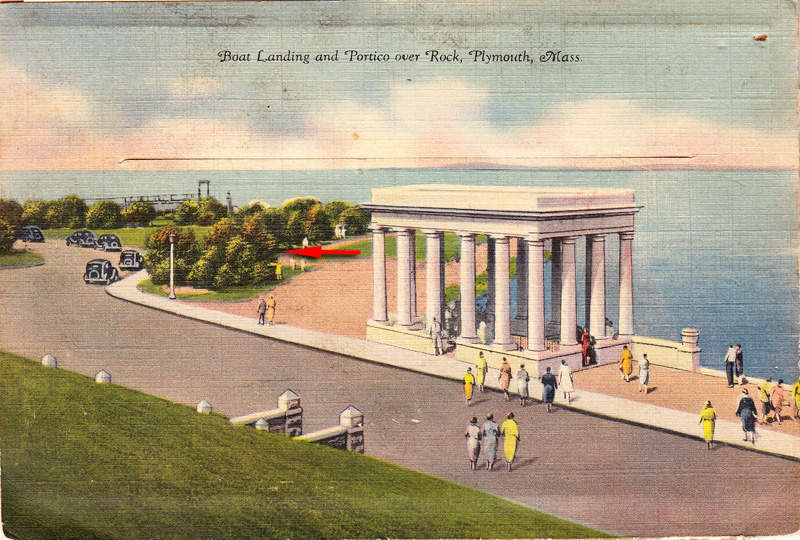
Here's an old photo of the actual Plymouth Rock that's under that big granite pavilion. It has the number 1620 engraved in it. That was the year the Pilgrims came to America from England. (It's also the number of tourists each week who actually believe this was the actual rock the Pilgrim's first stepped on.) 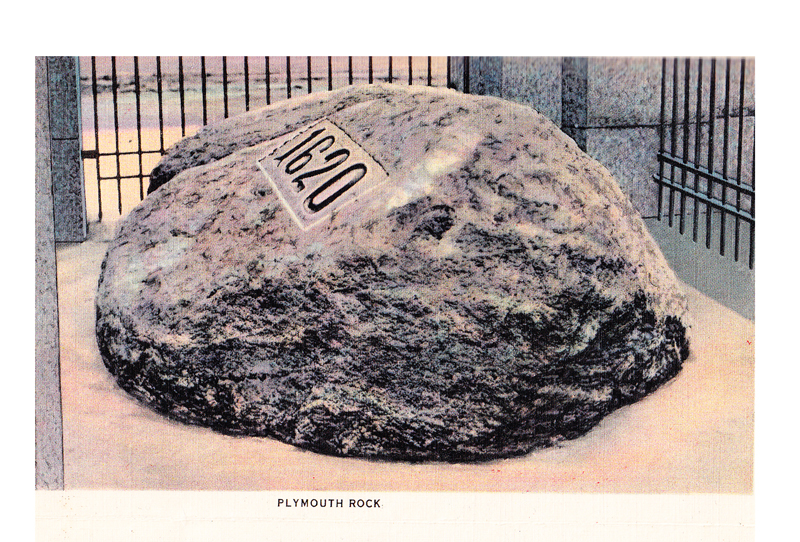
Here's another angle of the location of the Plymouth Rock pavilion and the park where the cover shot of Desire was shot. 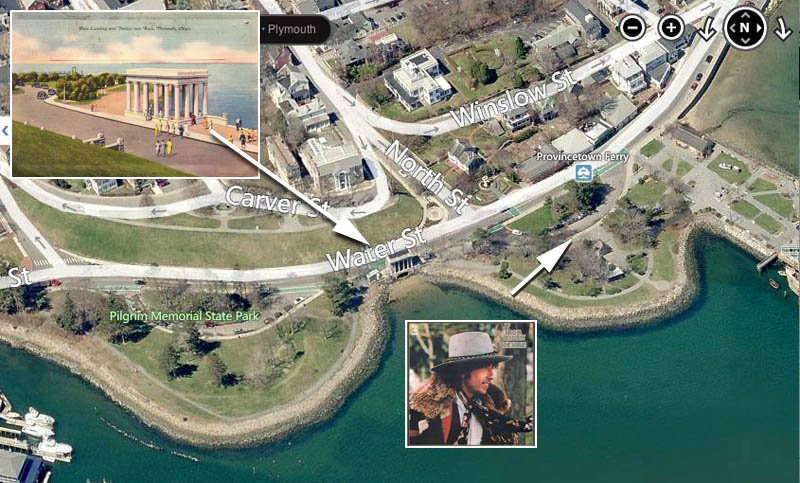
And here's where Plymouth, Massachusetts is located on a map. It's about an hour-and-a-half drive south of Boston. 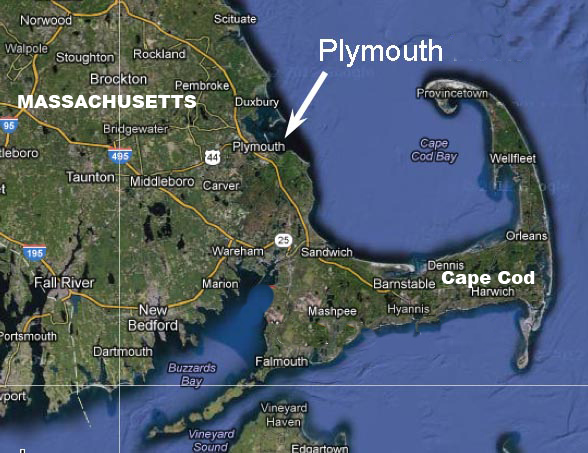
How I found the location (with a few assists along the way). The roots of the Desire album lie in Dylan's "Rolling Thunder Revue" (tour) of 1975-1976. And the roots of the Rolling Thunder Review lie with Dylan moving back to Greenwich Village, New York, following the release of Blood on the Tracks in January 1975. Dylan's creative juice's were flowing. Beginning in June, Dylan started hanging out at his early 60's haunts like The Other End (at the time combined with The Bitter End*), at 147-149 Bleecker Street (below). (* it's confusing, as the Other End was a combination of two spaces: there was an Other End - a bar serving liquor - at #149 Bleecker and an affiliated cabaret (where liquor was not allowed to be served) - soon to be called called The Bitter End -- at #147. Most performances took place at #147) 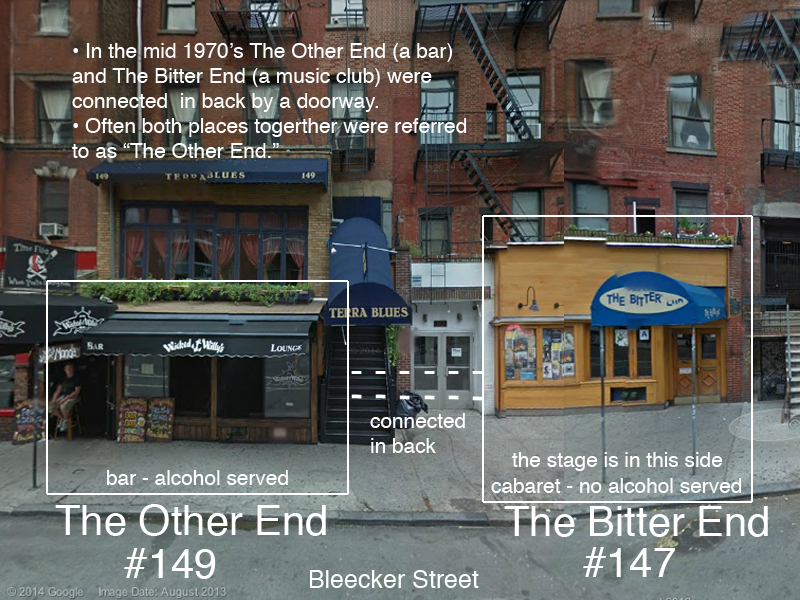
Starting in mid-July he also started writing songs with Jacque Levy, a local Village writer who directed the notorious off-Broadway erotic revue Oh! Calcutta! and wrote "Chestnut Mare" with Roger McGuinn of the Byrds. They would continue to write through August. Jacques Levy lived around the corner from The Other End, at 506 LaGuardia Place, midblock between Houston Street and Bleecker Street. Dylan would sometimes write with him there. They also wrote at Dylan's house in East Hampton, Long Island, on Lily Pond Lane, a street mentioned in his song Sara. .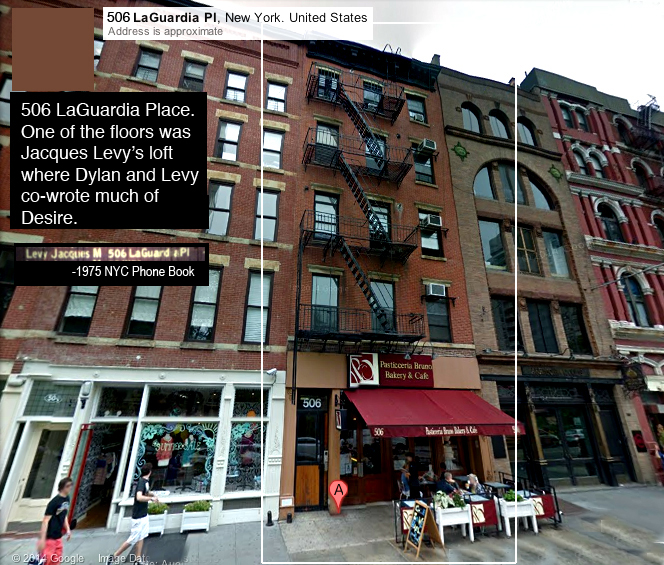
After seeing Patti Smith and her band one night (June 28, 1975; photo below) at The Bitter End cabaret section of The Other End, the legend goes (since others say Dylan discussed playing a circuit of small clubs earlier), Dylan decided that he wanted to play as part of a band again, and he started recruiting some friends to play small gigs throughout New England like a gypsy caravan. 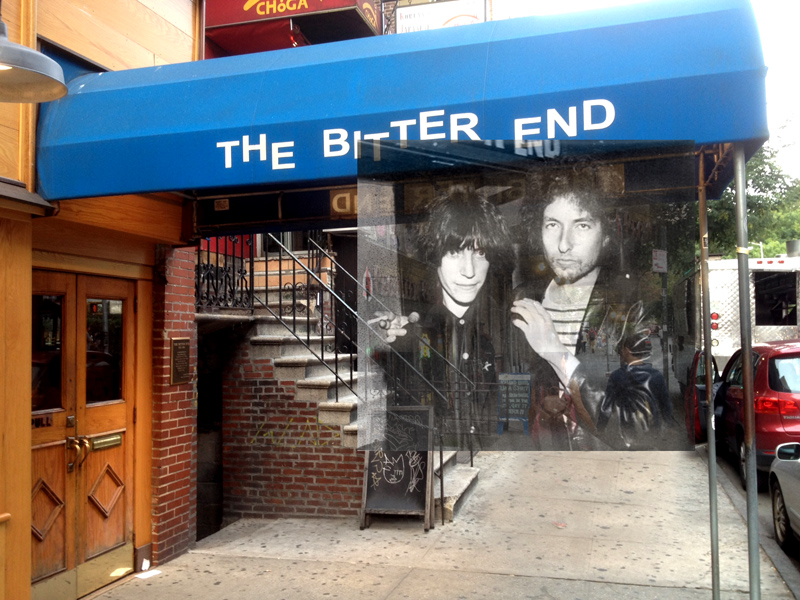
He would later name his band of traveling musicians "The Rolling Thunder Revue" (after a sound he said he heard on a rainy day in Woodstock). Dylan gathered musicians for his tour throughout the summer, and used a core group of them to record Desire between July 28th and August 2nd. The album came out on January 5, 1976 in the middle of the two halves of the Rolling Thunder tour The Rolling Thunder tour got together in October and played it's first date on October 30th, 1975 in Plymouth, Massachusetts. Below: Dylan at The Bitter End club on Bleecker Street with singer Ronnie Blakely and poet Allen Ginsberg, both of whom Dylan recruited for the tour. 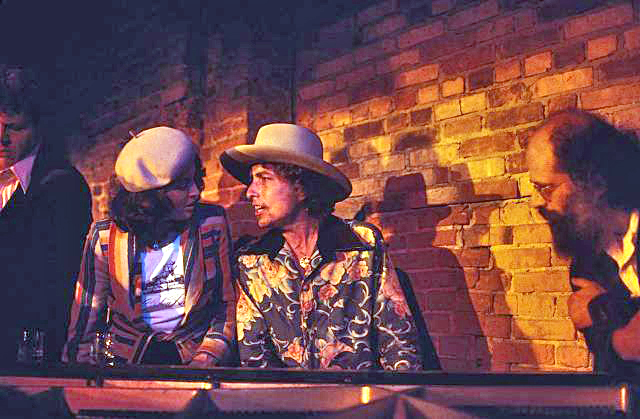
While the band practiced for several weeks during October late at night, with the windows covered, at the Bitter End, the Rolling Thunder Revue semi-officially began, with Dylan and Joan Baez singing together for the first time in 10 years at Gerde's Folk City. Gerde's had moved from 11 West 4th Street to new digs at 130 West 3rd Street near 6th Avenue by this time. Dylan and Baez, backed by some of the Rolling Thunder review, and other friends, were singing in celebration of the owner, Mike Porco's 60th birthday on October 23rd, 1975. Gerde's was where Dylan had gotten his big start after a review by Robert Sheldon in The New York Times in September 29 1961. Here is Dylan playing with Rob Stoner and Joan Baez at Gerde's. 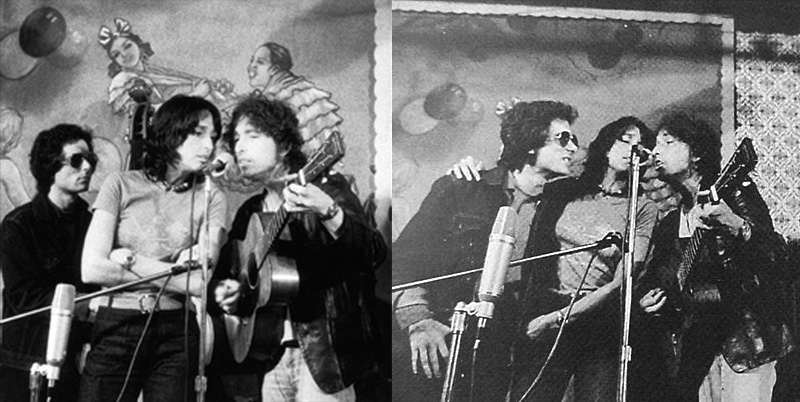
This is a poster for the tour that became known as The Rolling Thunder Revue and which played about 30 gigs throughout New England in 1975 and another 20 around the USA in the first months of 1976. This particular poster is for the Revue's 1st performance - at the Plymouth Memorial Hall on October 30 and 31st of 1975. The photos are (clockwise) Dylan, Ramblin' Jack Elliot, Bobby Neuwirth, and Joan Baez. 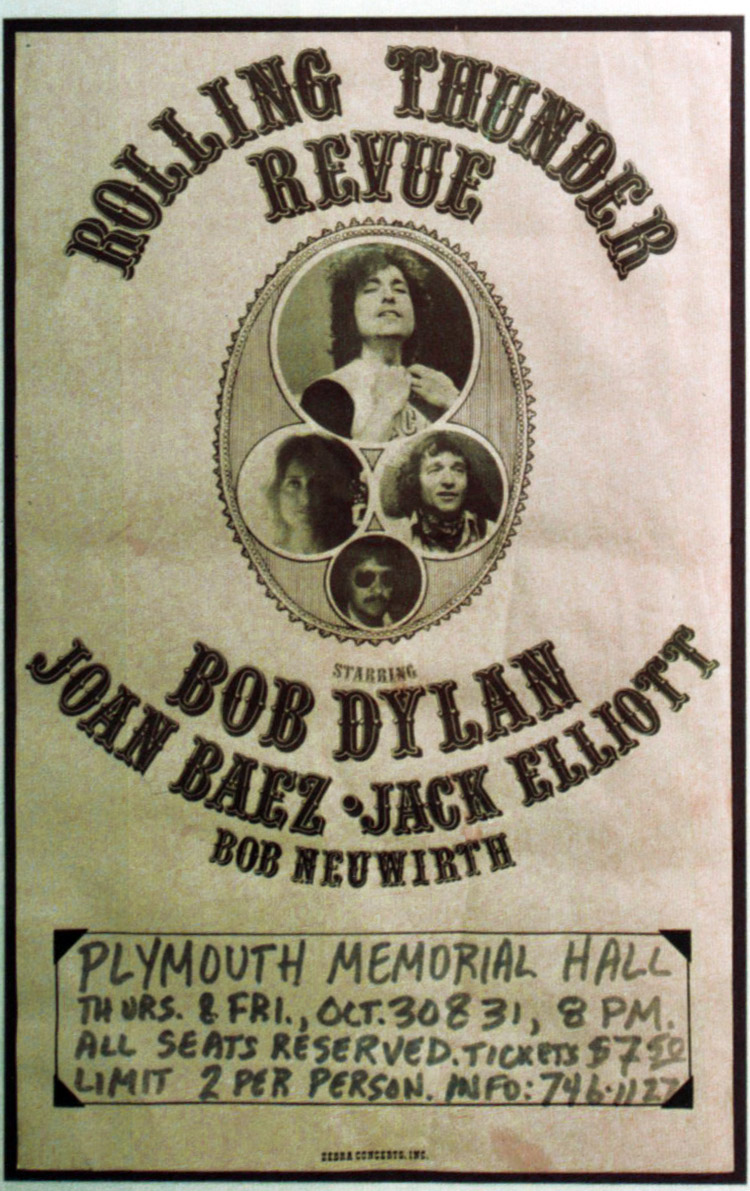
The first concert was at the Plymouth Memorial Hall in Plymouth, Massachusetts, the site of the Pilgrim landing. The Pilgrims were the first permanent European settlers on American soil. Here's another shot of the Plymouth Memorial Hall from an architectural firm that rehabilitated it. 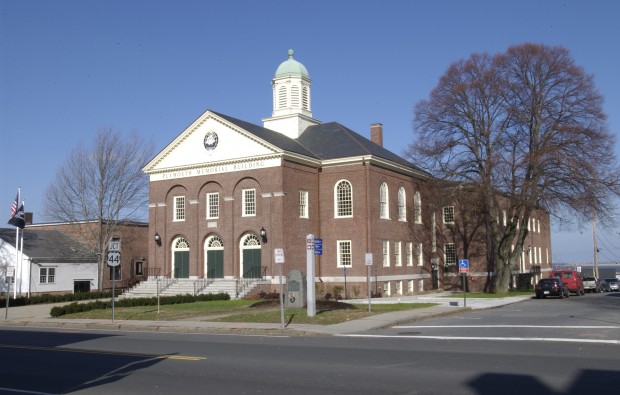
photo: Kirchhoff Consigli Construction Management And here's the interior of the Plymouth Memorial Hall. 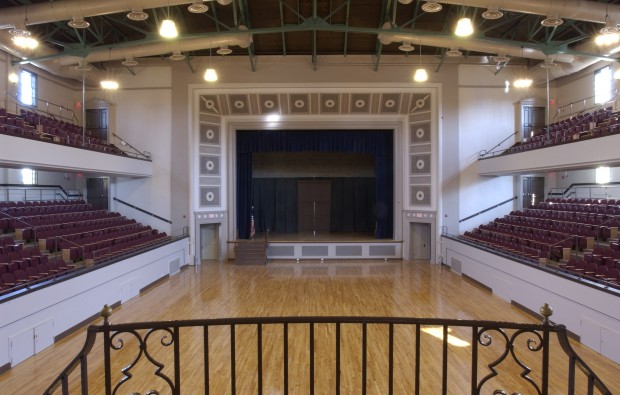
photo: Kirchhoff Consigli Construction Management The band and crew of the Rolling Thunder Revue stayed near Plymouth at the Sea Crest Motel in Falmouth, about a half hour away. (The hotel is at 350 Quaker Road and has since had a complete makeover.) 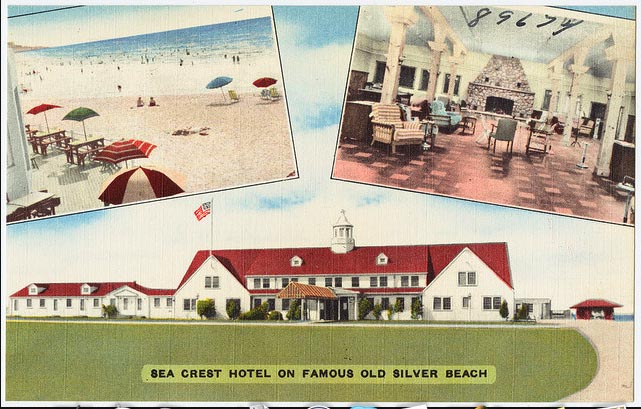
Here's a map showing the location of the Sea Crest Hotel and Plymouth. 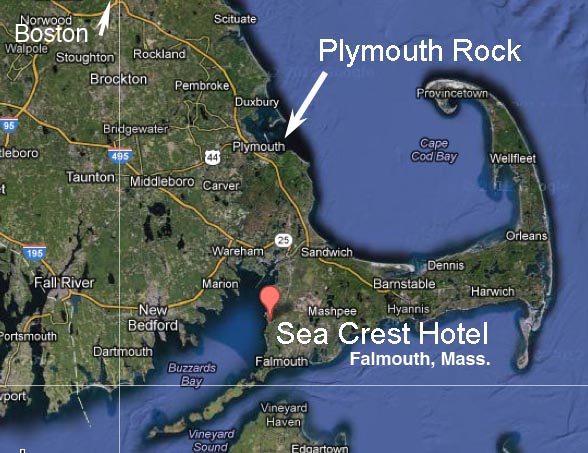
This is a photo of photographer Ken Regan with Bob Dylan in the 1980's. Ken was the official Rolling Thunder tour photographer and took the cover of Desire. 
In this photo, visitors are looking down at Plymouth Rock in 1976. The rock is symbolic of the arrival of the Pilgrims to American shores in 1620. As it was almost 100 years from the Declaration of Independence (1796), Dylan and his crew celebrated the U.S. Centennial of the founding of the country by landing on the beach at Plymouth as part of their experimental movie about the tour, eventually to be titled Renaldo and Clara. 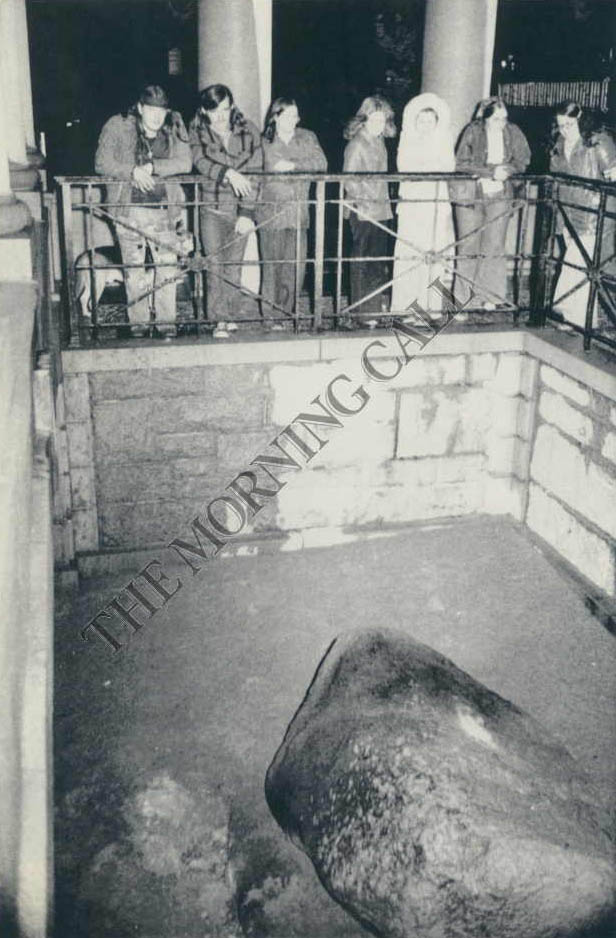
Here's an old tableau of Plymouth Rock indicating the significance of the rock. (In the background it looks like a sailor is doing the "Y" in the Village People's "YMCA" dance. 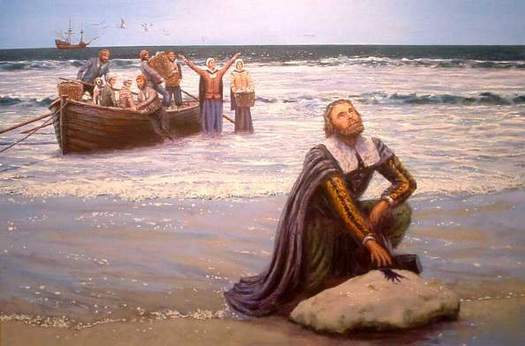
This is a shot of the annual Pilgrim's Thanksgiving parade that takes place each year in Plymouth. 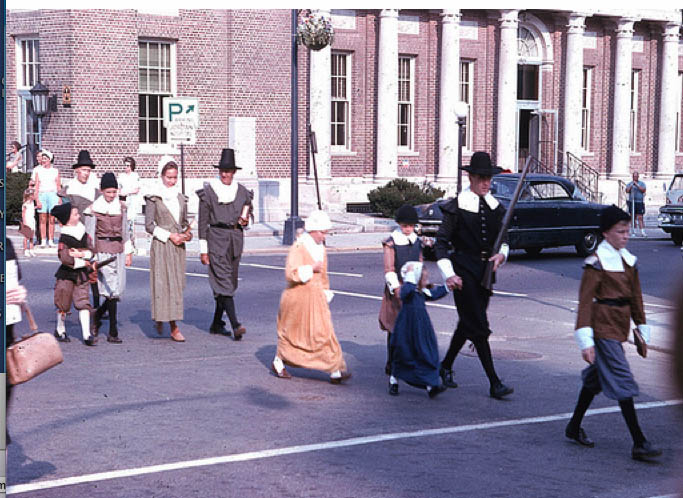
Thanksgiving, as this random photo I found on the Web indicates, celebrates Native Americans and Puritans working together for the common good. 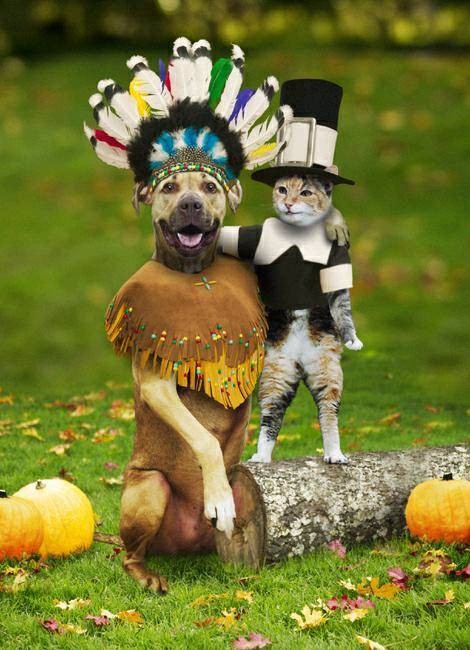
My son Nick picked up some cool glasses at one of the local the Mayflower gift shops when we visited several years ago. 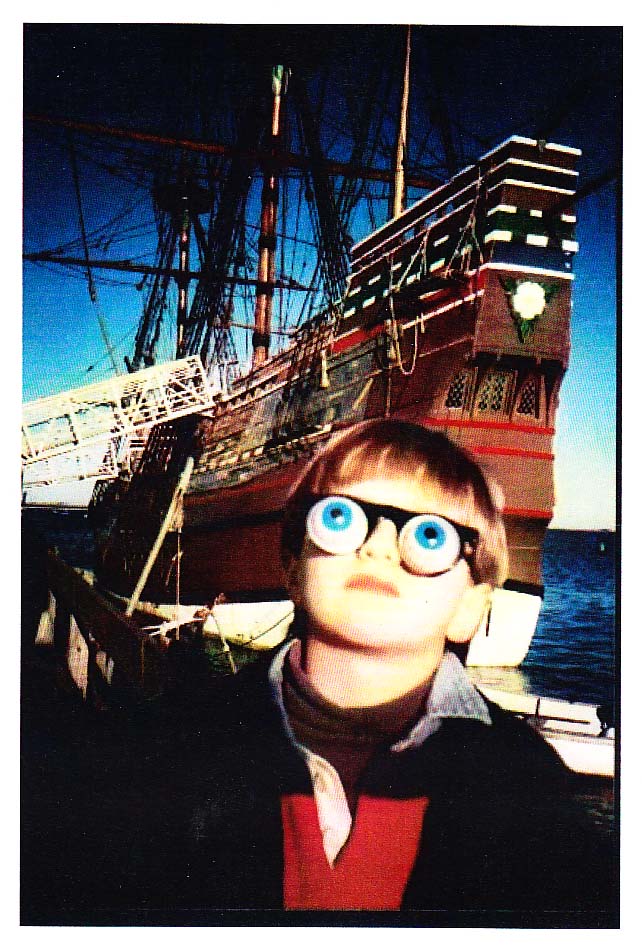
That was all just background to this, the location of the cover photo shoot: This (below) is a series of photos I found at the Bob Dylan Picture Archive - a website that collects photos of Dylan year by year and is a key research tool for Dylan researchers and historians. It is a group of photos, mostly taken by the official tour photographer Ken Regan, of one of the first days of the tour. On that day, the people Dylan hired to film the tour (under the direction of Howard Alk and Mel Howard) decided to shoot a scene where Dylan arrives on American soil by a boat, like the Pilgrims, with members of the Revue, and then they go and visit the Mayflower II. 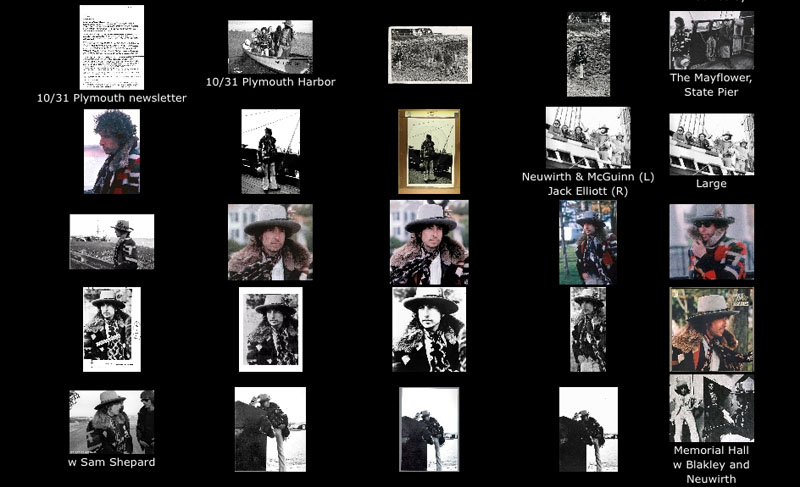
Here's a symbolic illustration of Dylan "re-discovering" America that I came across on the Google Images. (I don't know who the artist is but "thank you.") 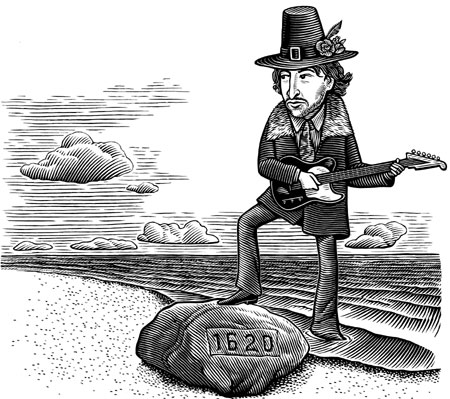
Here's Dylan and his crew arriving on Plymouth shore via boat. 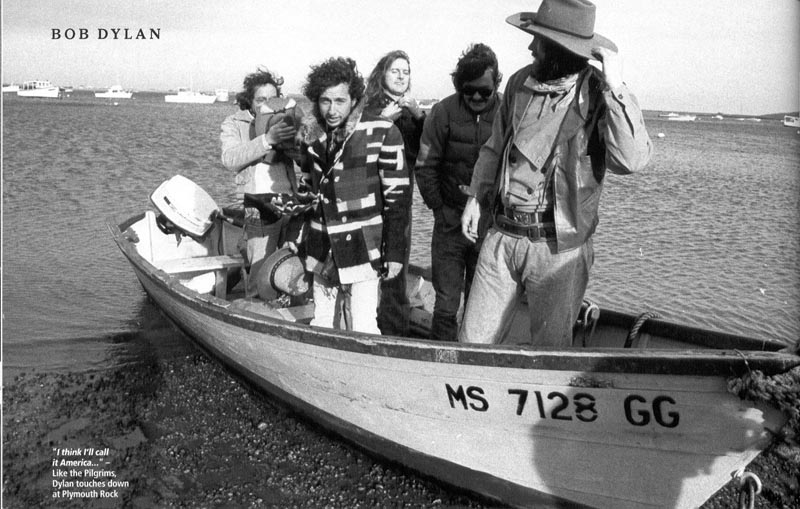
Photo by Ken Regan Dylan and his party disembark and walk up the rocky beach to the area around Plymouth Rock. Dylan's landing party includes, from left to right, Dylan, a bearded man in a cowboy hat who is still a mystery to me (Sam Shepard, in his book, says it's Peter Orlovsky, but Orlovsky had a ponytail), Roger McGuinn of "The Byrds," Bobby Neuwirth, and Ramblin' Jack Elliot. 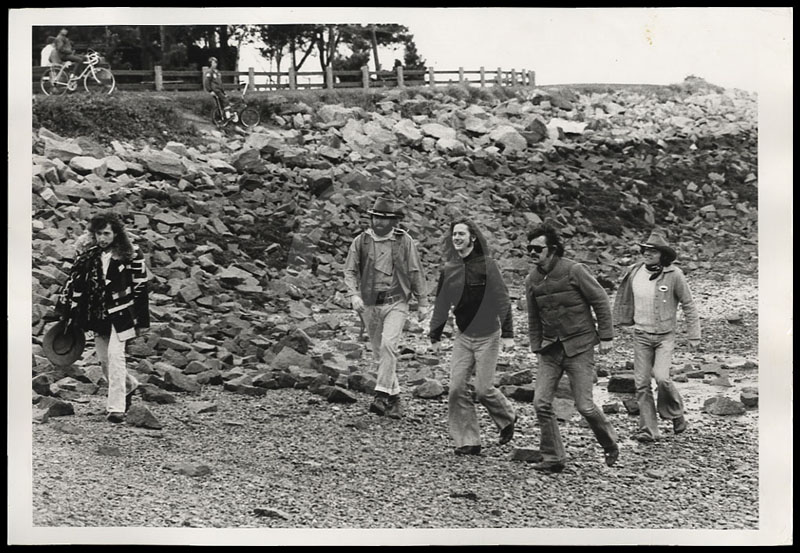
Photo by Ken Regan The rocky beach they walked up is in the center of this photo. As I reconstructed the events, they then walked past the Plymouth Rock pavilion at left, and then went to the right, through the park, to the replica of the Mayflower called the Mayflower II. 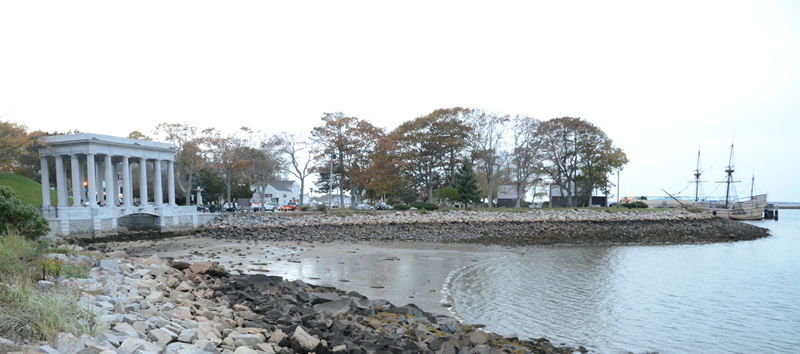
Here's what the scene looked like after they passed the pavilion. 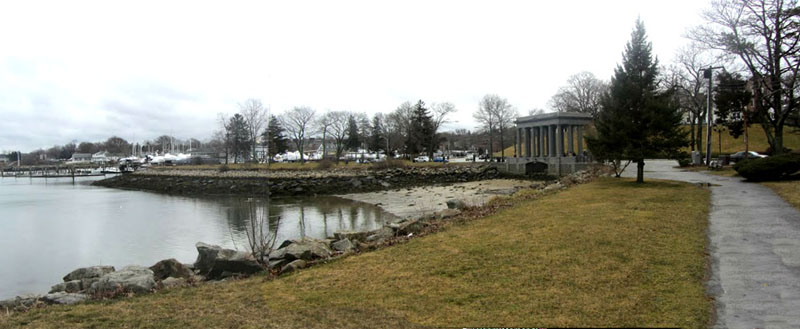
(In the Dylan Picture Archive, these next few pictures were depicted as coming after Dylan walked on the Mayflower II. But, as we shall later see, I discovered that they were taken following the landing on the beach, so I have inserted them here, so you get a feeling for the series of events.) In this next shot, Dylan is on land, thinking about turquoise. Behind him, to his left is a white house with black shutters. To his right there's a small gray vertical structure, like a statue, with a wide gray horizontal part near the top. 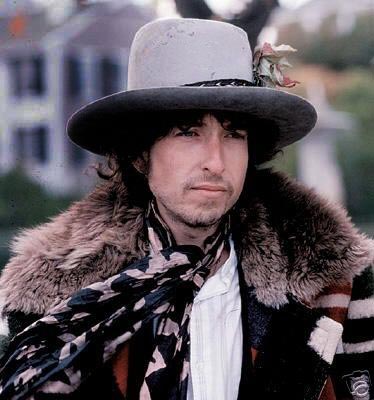
Photo by Ken Regan This next shot was a publicity release that was printed backwards, so I flipped it. 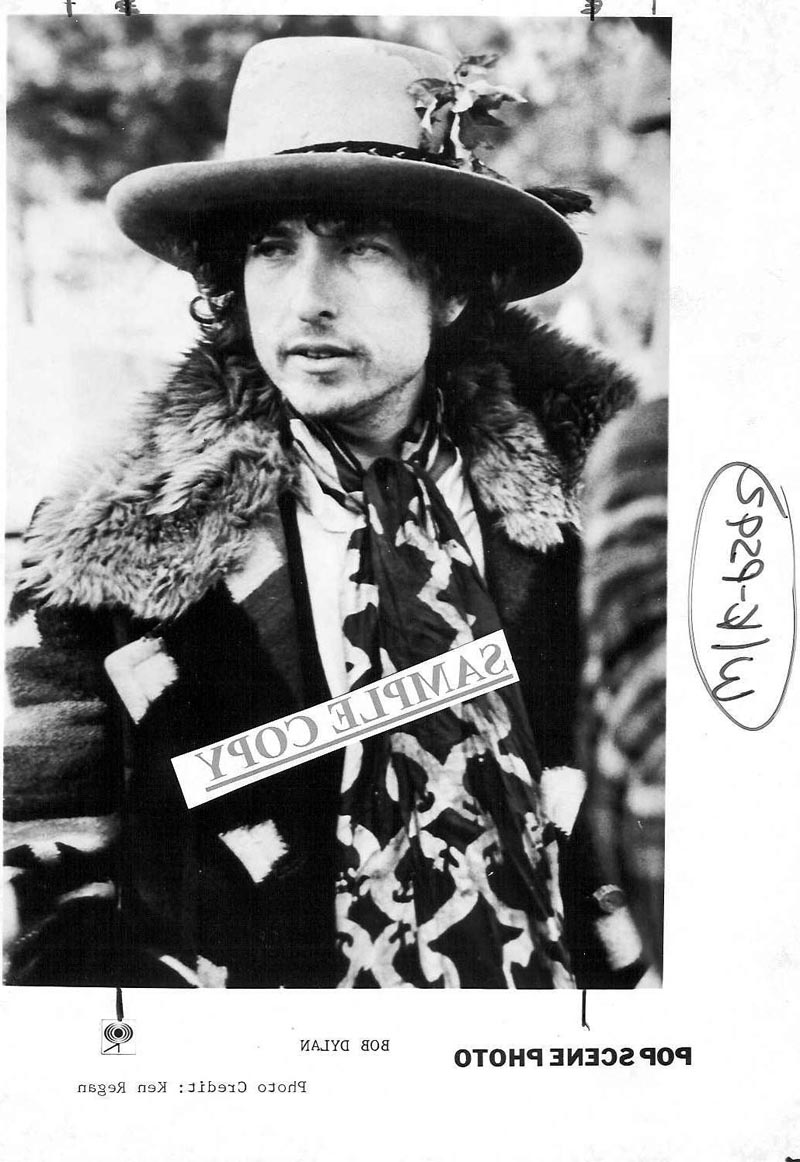
Photo by Ken Regan Here's the same shot, in color, printed correctly, and used on a music tablature book. You can see foliage behind him. We'll get back to this location - where the candid cover shot was snapped - later. 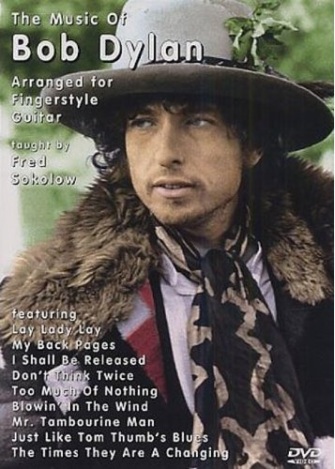
Photo by Ken Regan The Desirecover shot. Dylan has been photographed with a telephoto lens like just the last few shots. In this we see more of the trees behind him. 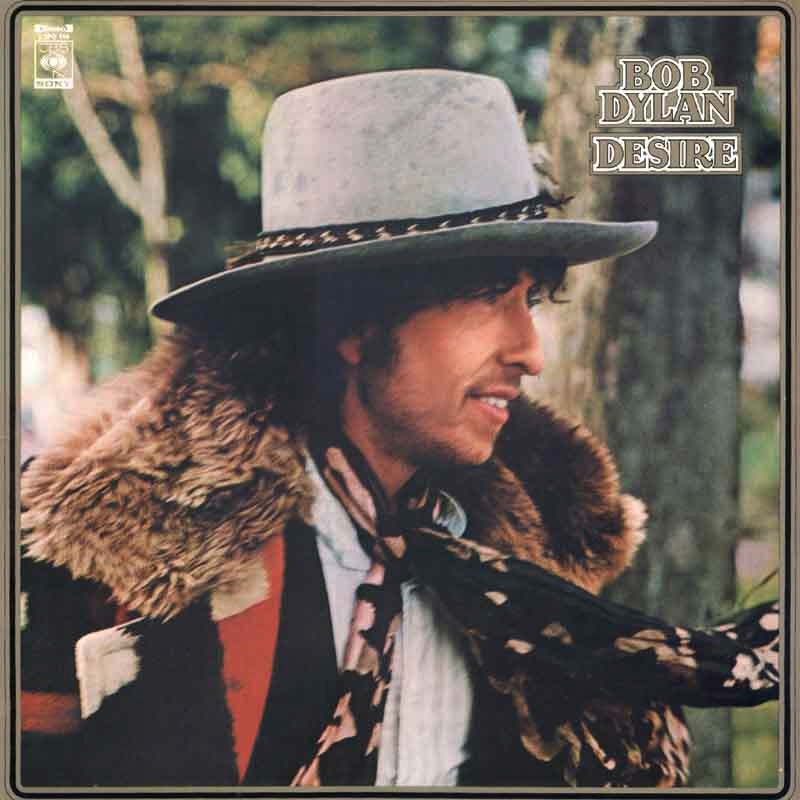
Cover photo by Ken Regan Dylan is still in the park between Plymouth Rock and the Mayflower II. He is talking with Sam Shepard who was hired to write impromptu scenes for what will beRenaldo & Clara (and will go on to write The Rolling Thunder Revue Logbook) and Howard Alk, a documentarian and buddy of Dylan, hired to help assemble the film. 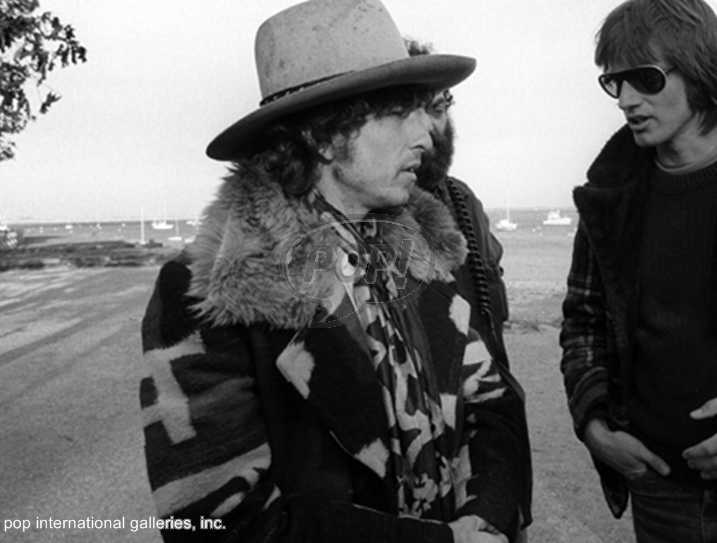
Photo by Ken Regan Dylan turns to check out the Mayflower II in the background 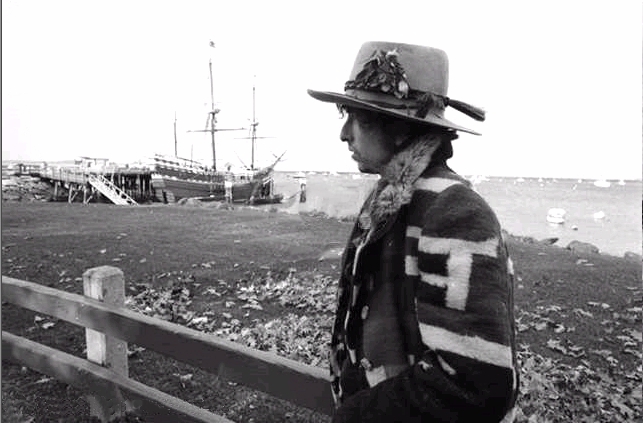
Photo by Ken Regan When I asked my brother Jim, who lives an hour away, to drive over and match up the shots, he stood in the same spot. Here's a modern day version of the shot, sans Dylan. In this next shot from the Bob Dylan Picture Archives, Dylan is on the deck of The Mayflower II 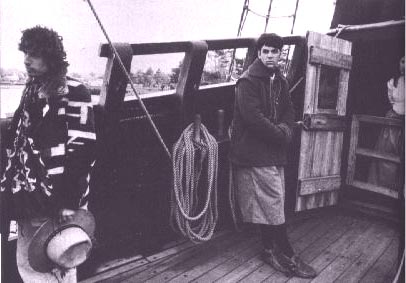
Photo by Ken Regan Here he is from another angle. Perhaps getting his sea legs. 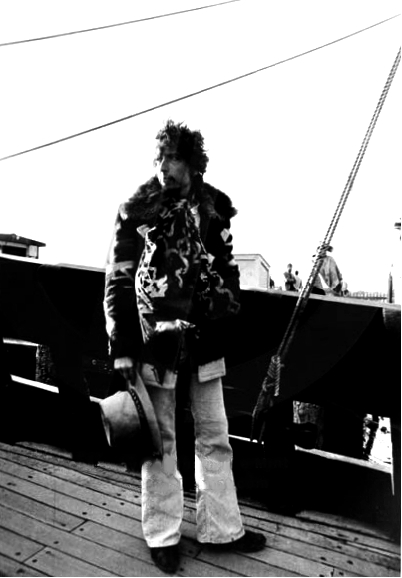
Photo by Ken Regan The photographer goes in for a close-up... 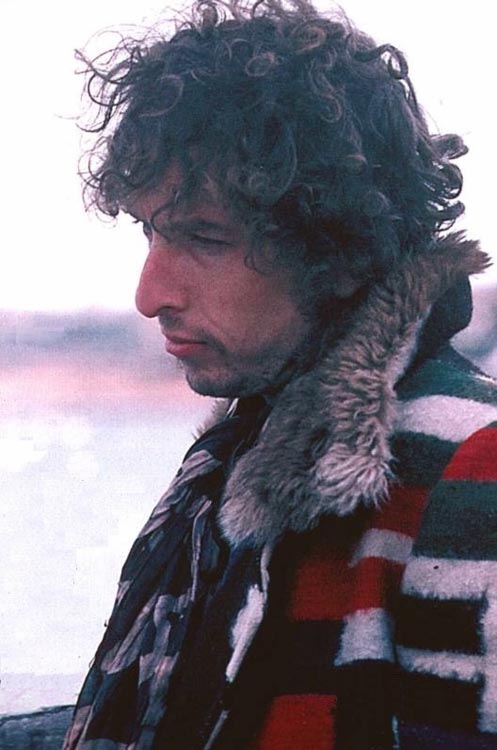
Photo by Ken Regan ...which will, over 40 years later, be used on a DVD cover. 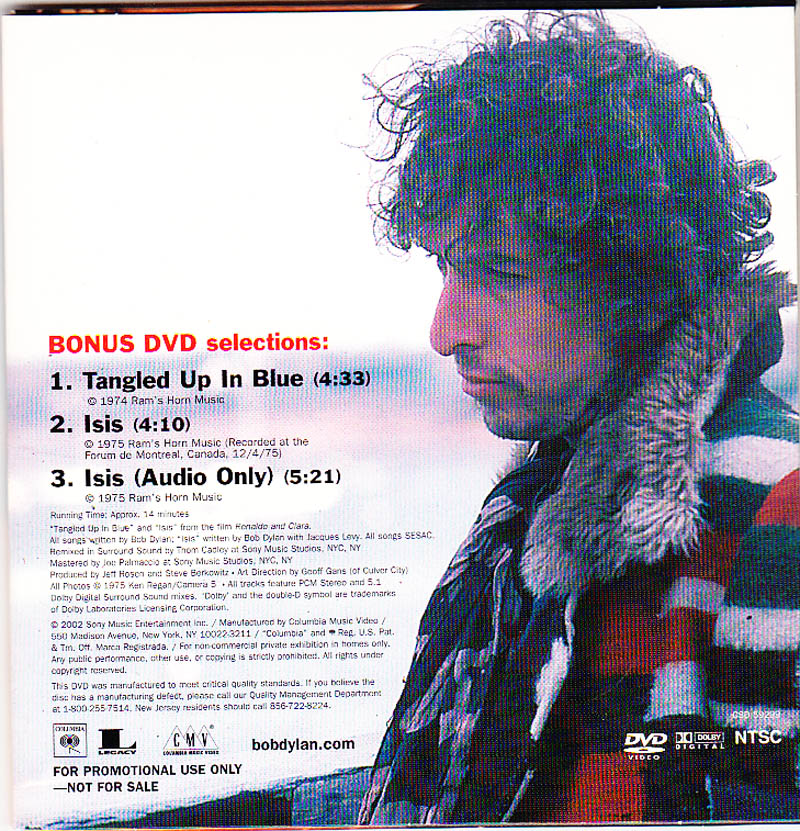
CD photo by Ken Regan Once again the musicians who arrived on the boat are seen on the Mayflower II. Check out the size of Roger McGuinn's portable phone. 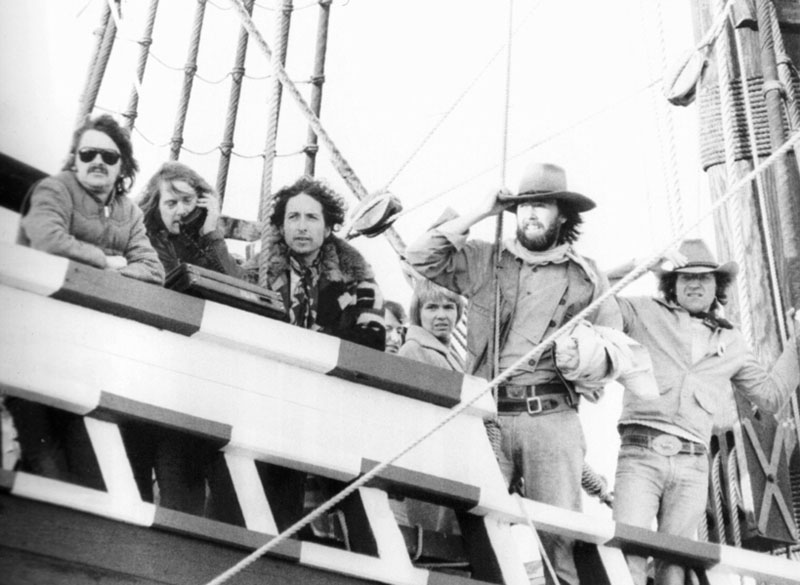
Photo by Ken Regan Dylan is now off the boat, and holding his hat from a brisk wind while resting his sea-leg on a refuse can.
Photo by Ken Regan Invigorated by the crisp sea air, Dylan goes for a little run. 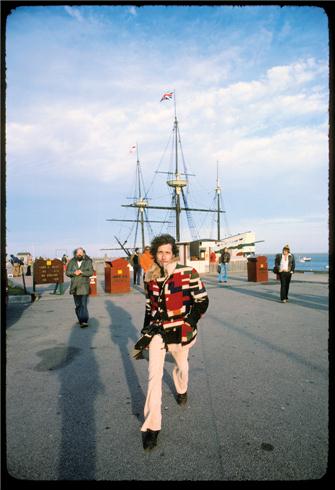
Photo by Ken Regan Marie, my "Senior European PopSpot Associate," who loves tracking down all things Dylan, matched up the spot where Dylan had propped up his feet. 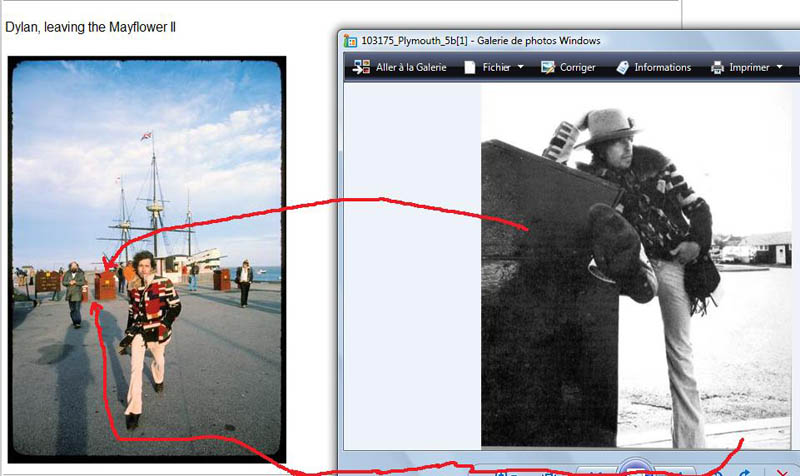
Photos by Ken Regan The red line in the photo below shows where Dylan was running. When I first saw these shots I had not figured where the cover shot was, since the photos from the Dylan Picture Archive seemed to indicate that the cover shot was taken after they were on the boat, so I searched several blocks of that side of Plymouth with Google Street Views for the cover location to no avail. 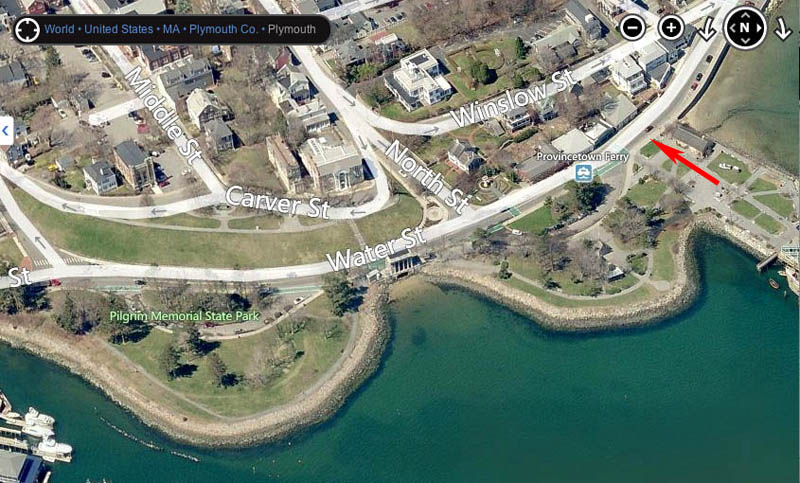
So, at this point in my search, since the Dylan Archive photos didn't provide enough clues, I decided to look at other photographs for clues and see what they offered. The first was this bootleg album entitled "Plymouth Rock." 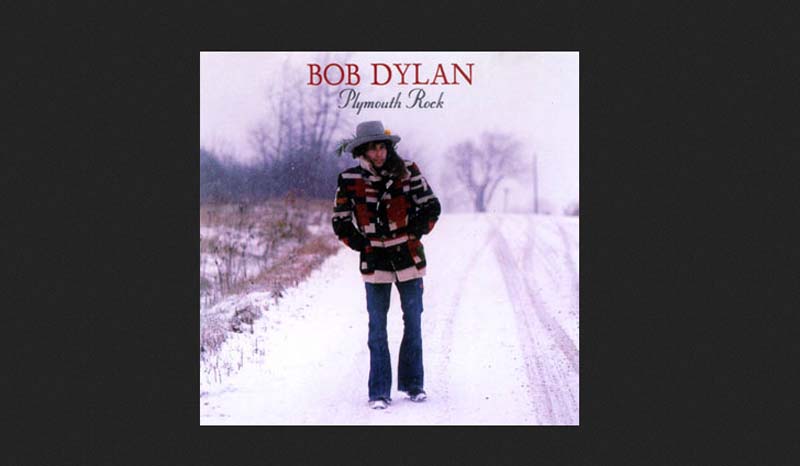
Cover photo by Ken Regan It certainly didn't look like any of the shots of Dylan at Plymouth, where there wasn't any snow. Also, Dylan had a feather on the left (as we look at it) side of his hat in this photo, which he didn't in the Plymouth photos.
Photo by Ken Regan This is the original photo. It's by Ken Regan, the official Rolling Thunder Revue photographer. 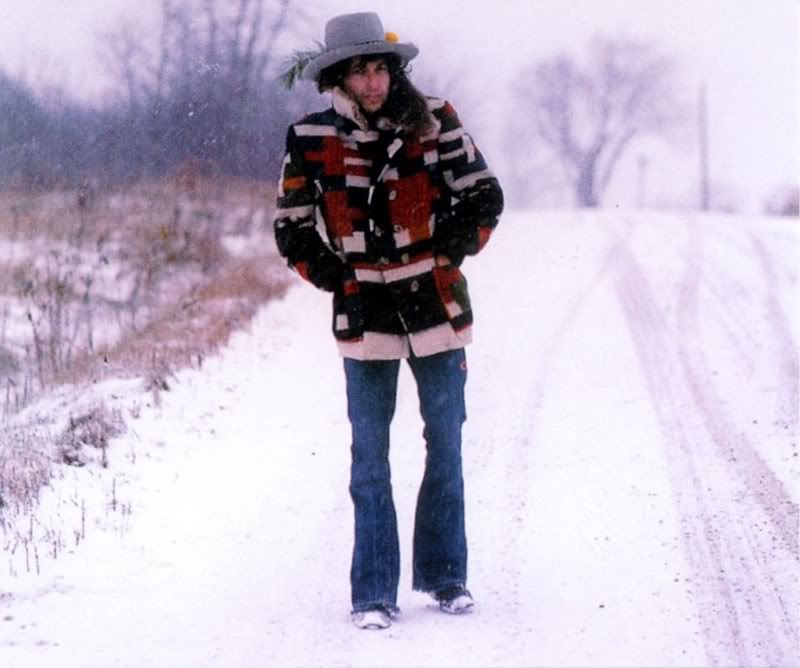
Photo by Ken Regan With a little searching, I found that it was taken in Maine... 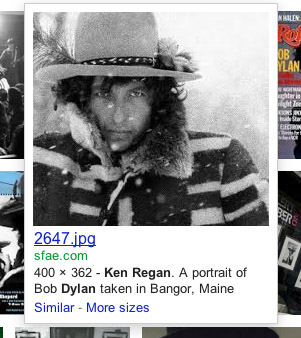
...which made perfect sense, since, as this date-list of the Revue shows, the Plymouth pictures were taken in late fall at the beginning of the tour, and the Maine photo was taken a month later in wintery Bangor, Maine, four-and-a-half hour's drive north. 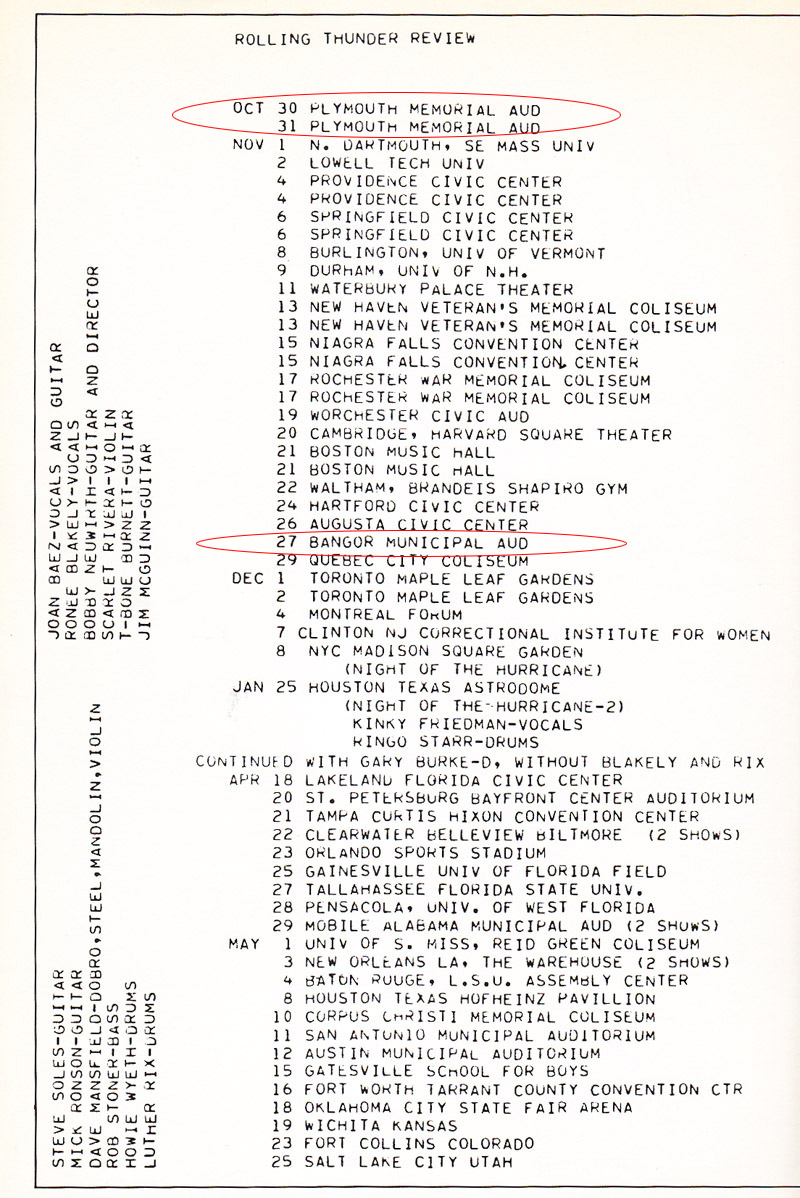
By the way, Dylan has said that this similar Ken Regan photo, which was the cover of The Bootleg Series: Volume 5: Bob Dylan Live 1975, was one of his favorites, and he waited several years for just the right album to put it on. (The photo was taken during the tour in New Haven, Connecticut at the New Haven Veterens Colisieum.) 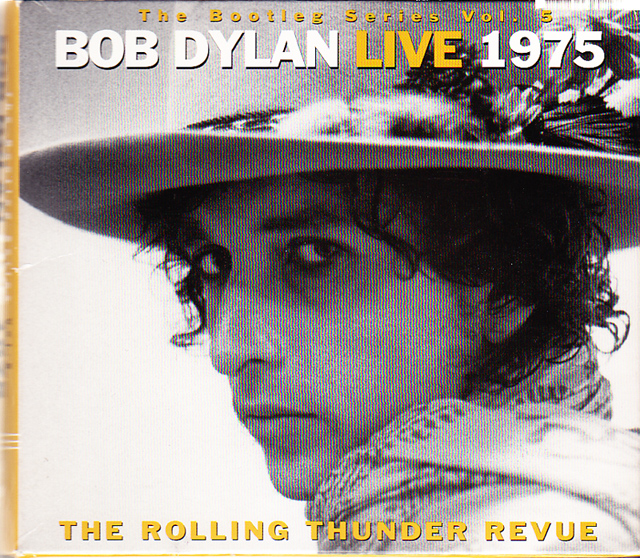
CD cover photo by Ken Regan I also looked through Renaldo & Clara, the movie filmed during the Rolling Thunder Revue, to see if the Desire cover shot came from any scene in it, but nothing matched up. Here's Bob in a scene with Joan Baez. 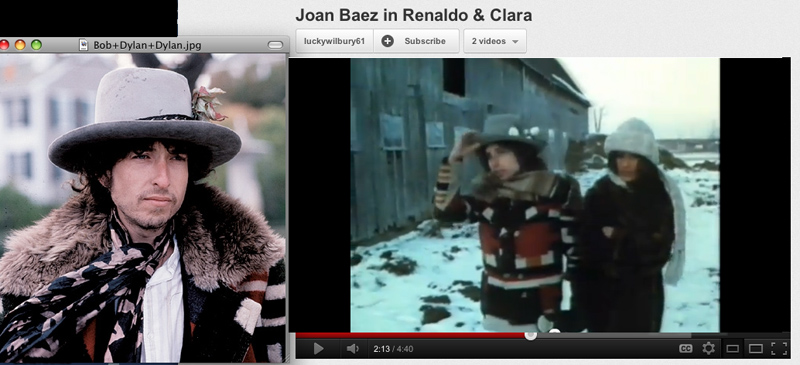
left: photo by Ken Regan; right: still from Renaldo & Clara I also went through the itinerary of the Rolling Thunder Revue to see if any of the lodgings matched up. This is a photo of the Red Lion Inn, in Stockbridge, Mass. where the troupe stayed, for example, but there was no match up. 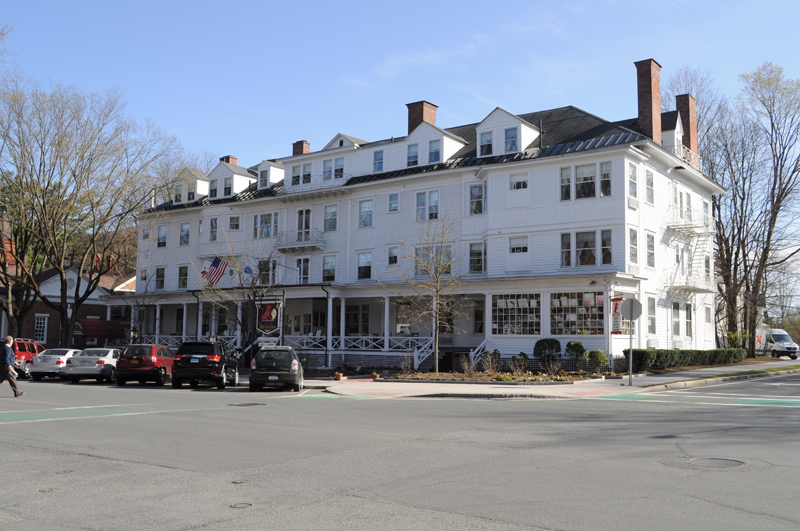
Back in Plymouth, I wondered if the white building with the black shutters in the photos taken at the same time as the cover shot, might have been the Plymouth Wax Museum, which is located on the hill above the Plymouth Rock pavilion. 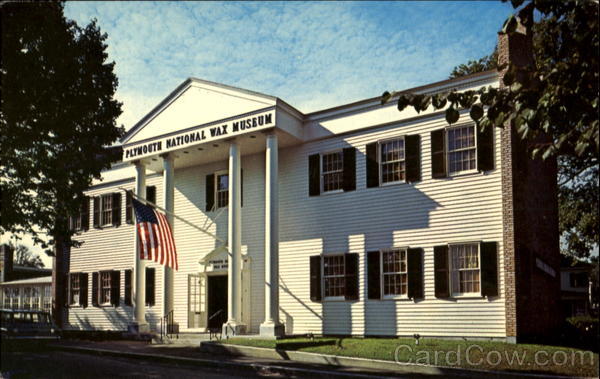
...but the angle was too steep. It would have been out of frame, above the background behind Dylan. 
The Wax Museum was located in the same spot where this old yellow inn was - on a hill above from Plymouth Rock. 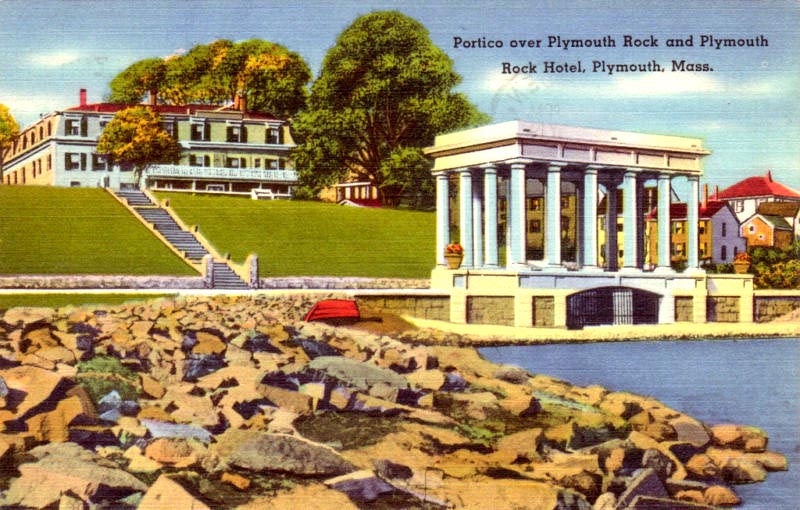
And near that Inn, also on the hill, was a stature of an American Indian, Chief Massasoit.... 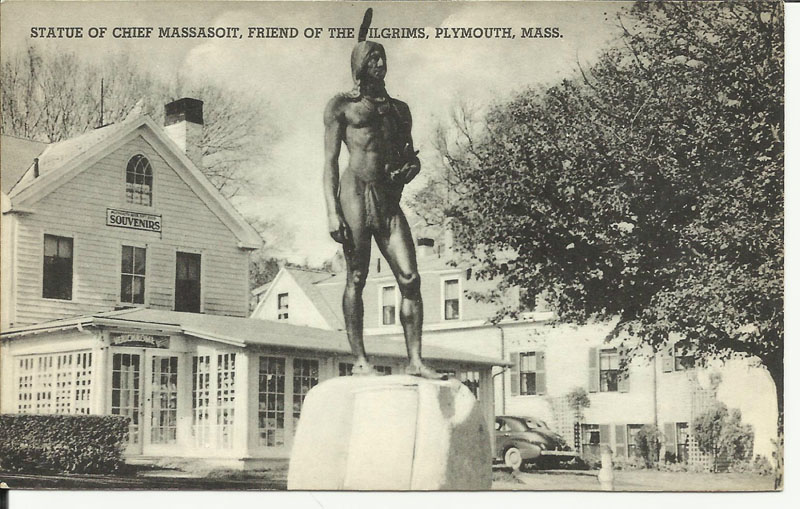
...over looking the sea below 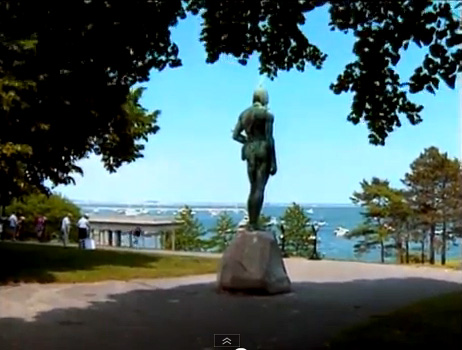
Just across the street from the Wax Museum, to the north, was this statue of the "Pilgrim Mother." It had a white house with black shutters behind it, similar to the shots taken right before the album cover shot, but I discounted it, because I thought the statue was located on a hill as high as the Wax Museum, and therefor couldn't have been in the background any of the Dylan shots. 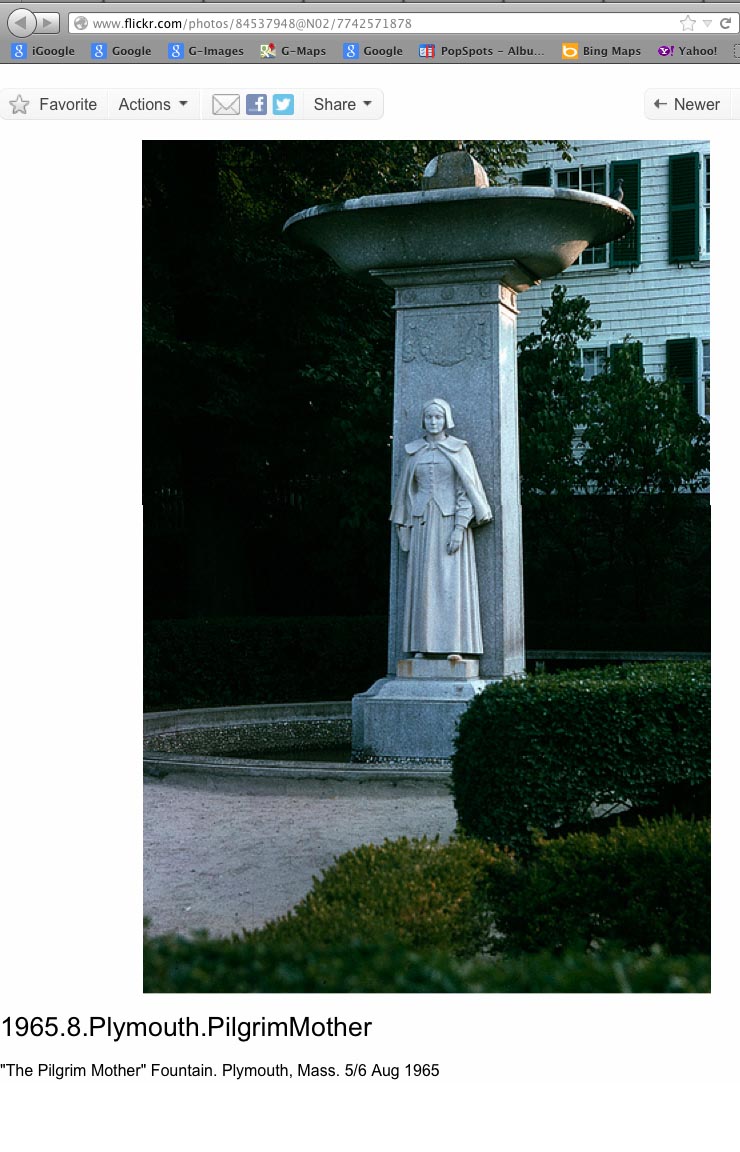
Here's an overhead shot of the Pilgrim Mother statue, and the house, now painted gray. The Wax Museum would have been off to the left. (Out of frame, just beyond Carver Street.) 
So I sent what I had to Marie in France for her thoughts, and she sent back the following photos tying together the house and fountain behind Dylan. It looked right, but I still thought the house and fountain were on a hill, like the Wax Museum. 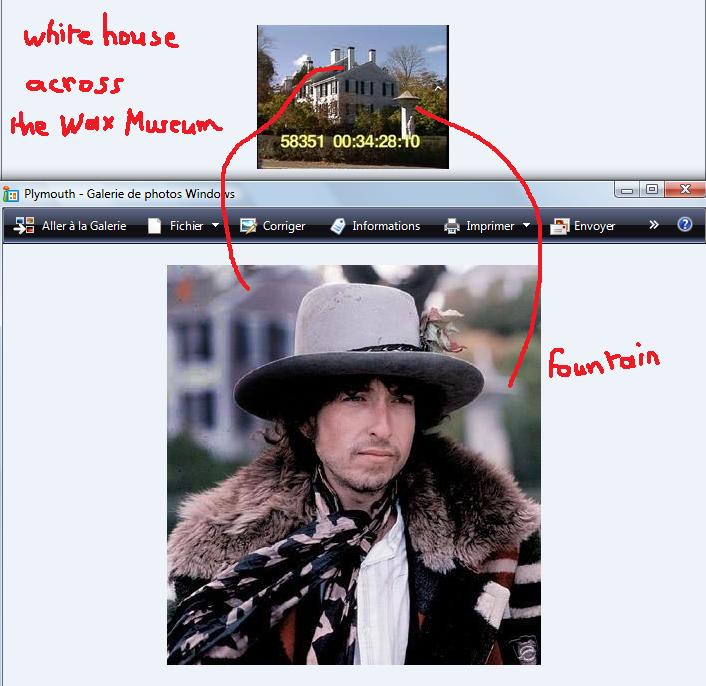
Photo by Ken Regan She also marked up my overheat shot to show the spot. 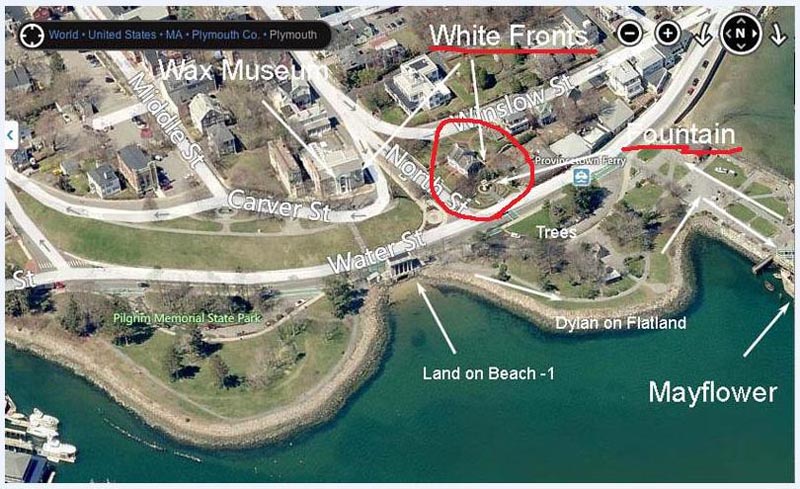
Well, that all sounded reasonable, but all my overhead viewing of Plymouth had indicated to me that the "Plymouth Mother" was on a Hill. So I looked for new photos of it. This was the first I found. It didn't look like it was on a hill. A postcard of the Plymouth Mother statue. 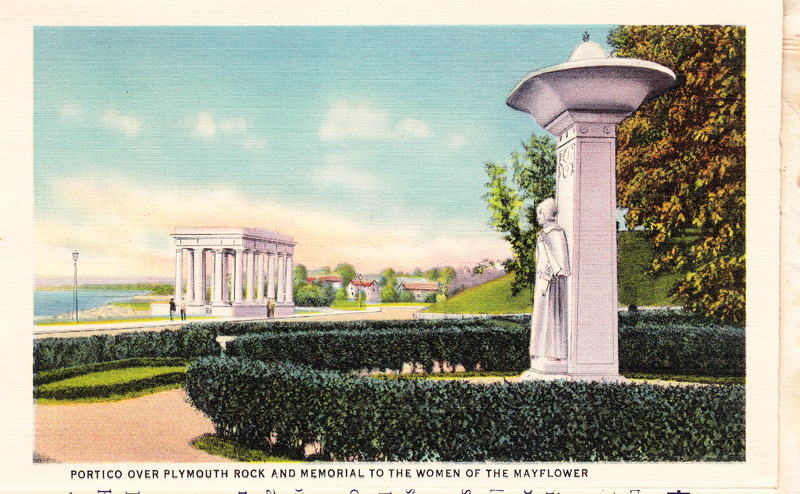
And in this second shot, you can see the steep hill across the street, where the Wax Museum was, but here - it's flat land. 
That would mean that the background of this photo, taken right before the album cover, was taken with the Plymouth Mother statue behind it. 
Photo by Ken Regan So, just to prove again to myself that it was flat, I found a video on YouTube of a man giving a lecture about the Plymouth Mother statue. 
In the middle of the video, the camera spins around to reveal the street across from the Pilgrim Mother statue. And you can see from this panorama, that I made from several frames of the film, that the Pilgrim Mother statue is at the same level as Dylan would have been across the street. So that's where Dylan must have been standing in those photos. I said to myself. Far out! (Having been a teenager in the 60's I can say those phrases.) .
So now I had the approximate spot of where several photo of Dylan had been taken by Ken Regan right before the cover shot. We've seen those shots earlier. But I needed to see for myself. So I did the next best thing. I enlisted my brother Jim, who lives in Newport, Rhode Island, an hour's drive from Plymouth, and a guy always interested in "solving mysteries without any clues" to go check things out. He went right to Plymouth Memorial State Park and surveyed the landscape. Here's the panorama shot we saw earlier: Plymouth Rock on the left, the Mayflower II on the right. In the photo we saw earlier of Dylan, Sam Shepard (the tour writer), and Howard Alk (one of the tour videographers), were standing right near the park benches on the right. 
Walking back to the Plymouth Rock pavilion, Jim noticed this "y" shaped tree." 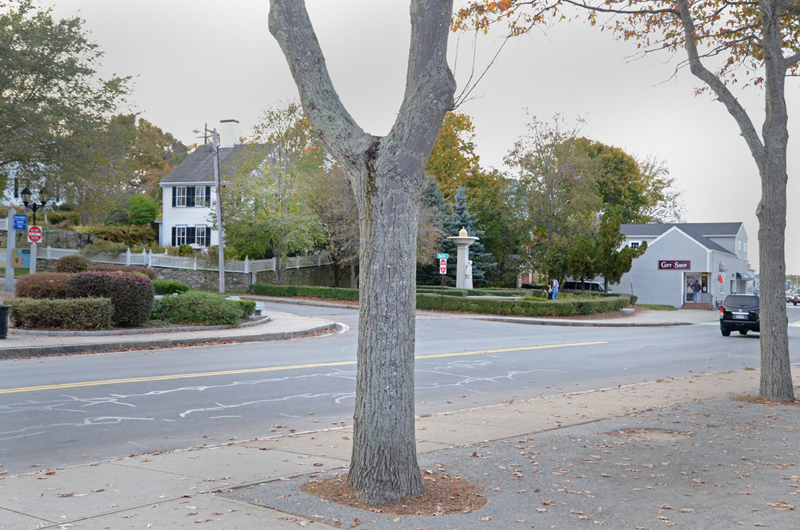
It was the tree behind Dylan's hat - all grown up. And the "white-house-with-black-shutters" and Pilgrim Mother statue all fit in, too. 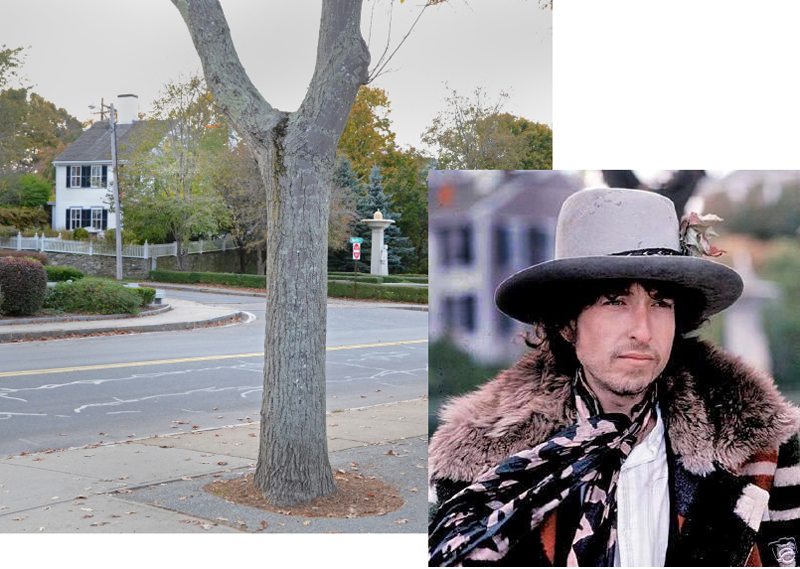
Insert photo by Ken Regan Walking back into the park, brother Jim searched for the background to this shot below. 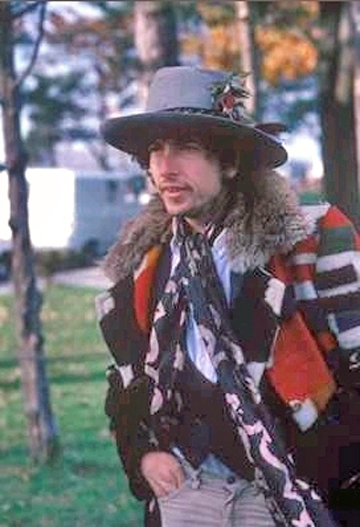
Photo by Ken Regan Not far into the park, he found this location. 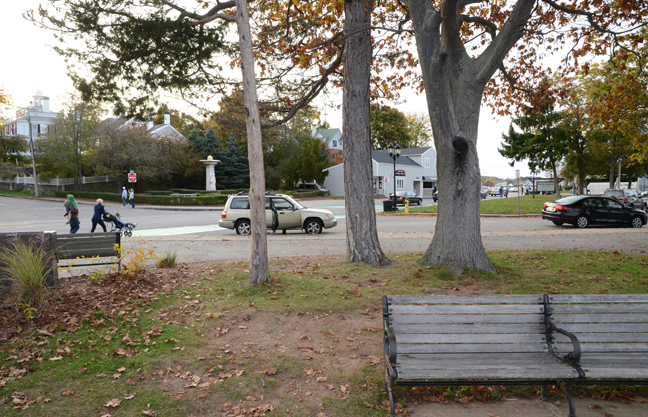
It also seemed to fit perfectly. 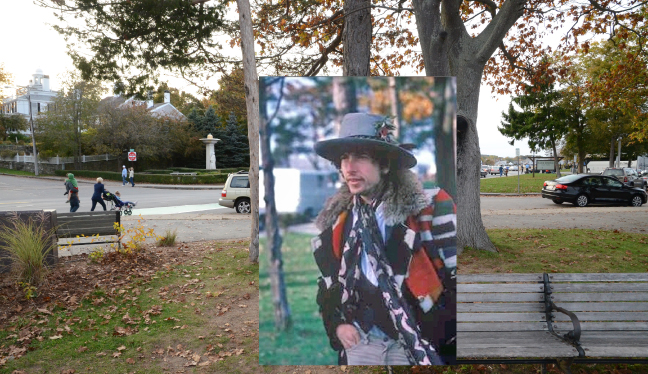
Insert photo by Ken Regan Here's where we are from the other direction. 
So now we come to the cover shot. 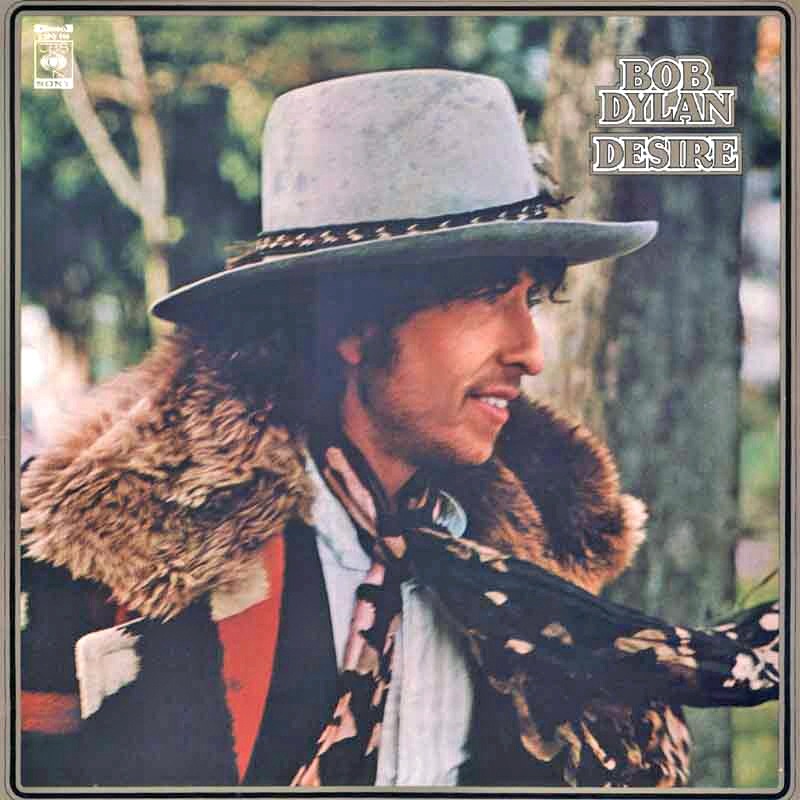
Since this was in a tree-lined location, taken right after the other "Pilgrim Mother" shots and most likely before the shot of Dylan, Sam Shepard, and Howard Alk, it was most likely taken right here in this glade of trees in the middle of Plymouth Memorial State Park. 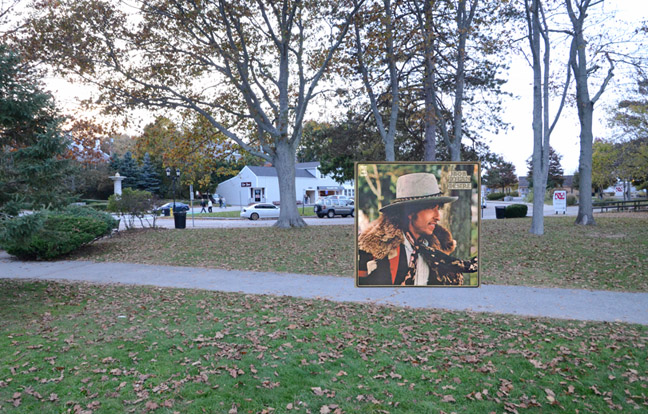
Here's a closer version... 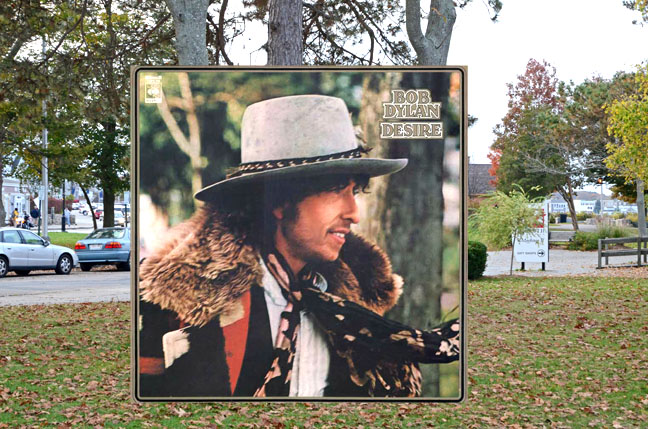
...and here are the trees today, still reminiscing with each other about the day the Rolling Thunder Revue landed ashore in Plymouth and made them immortal with the "click " of a camera. 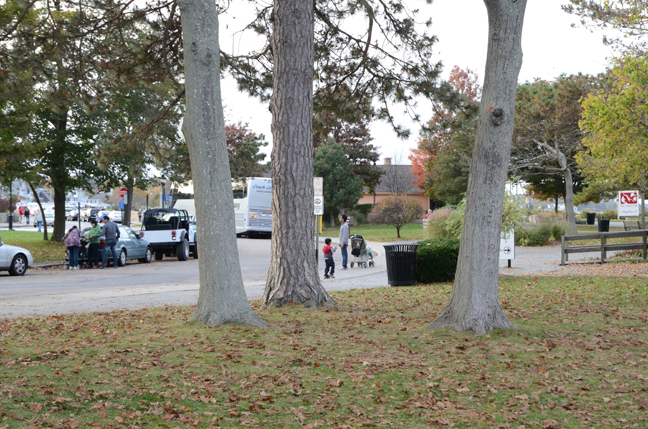
(2019 update) To see the park in Plymouth where the photo was shot in Google Street View, click here. Be sure to see THE ADDENDUM following the THE END sign for background information on the photos of the rear cover of theDesire album. 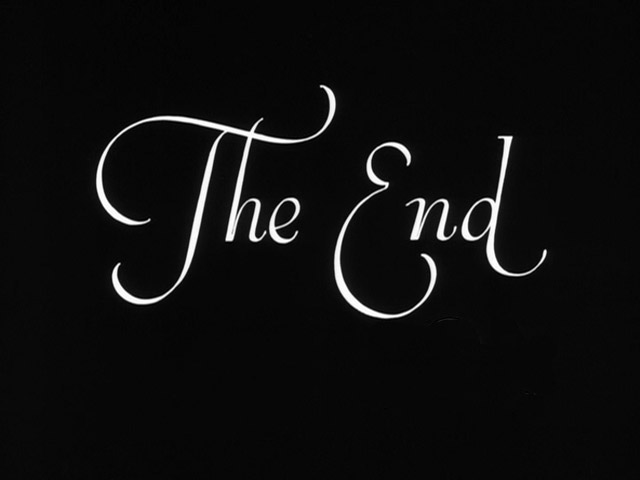
ADDENDUM #1 - THE BACK COVER OF THE ALBUM. The back cover photographs were taken by Ruth Bernal, The collage was put together by Carl Berile. And the album look as a whole was designed by John Berg. 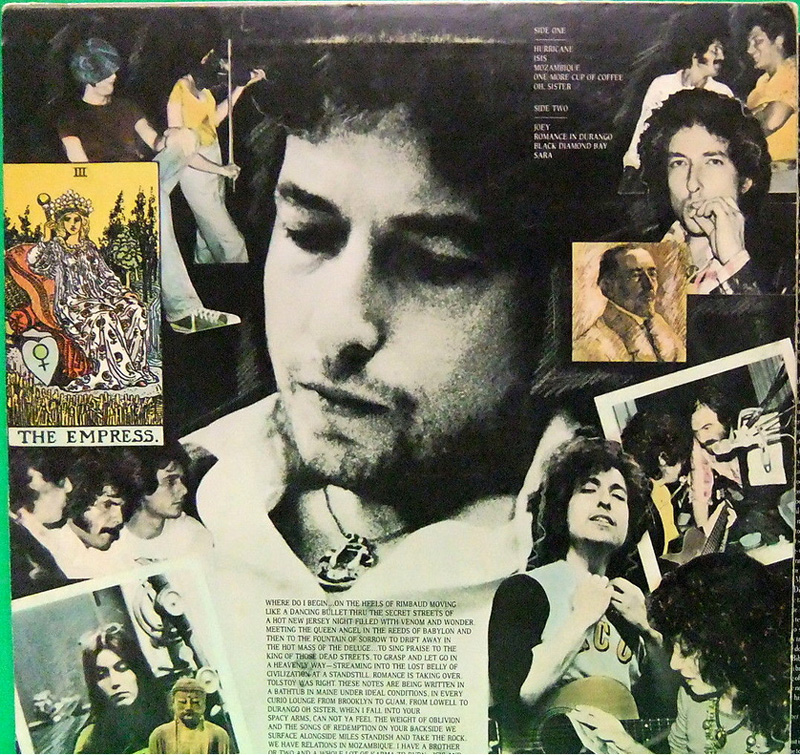
Here's an isolated look at the large photo of Dylan on the back taken by Ruth Bernal. 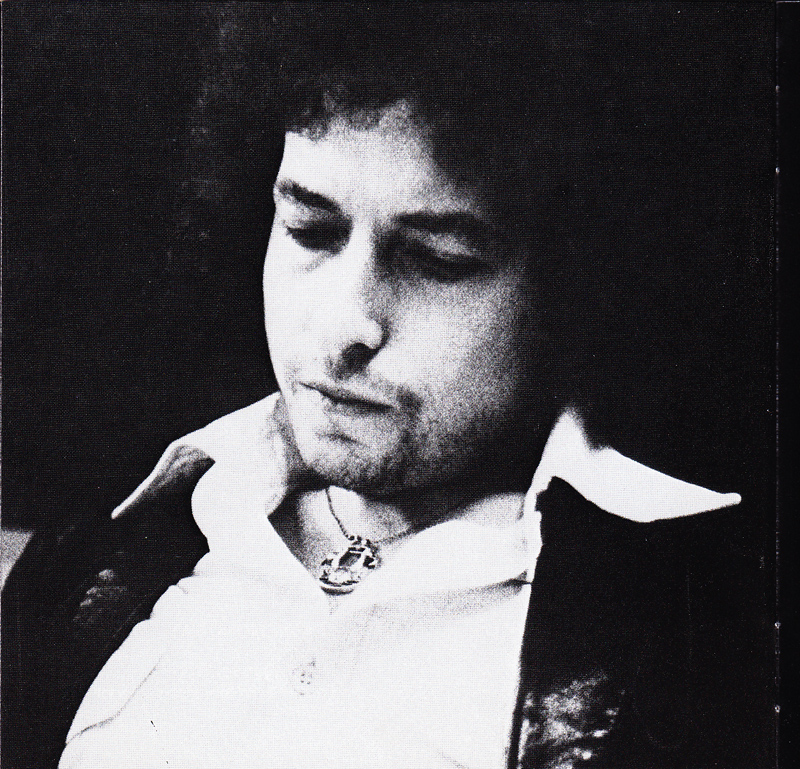
Photo by Ruth Bernal The man talking to Dylan in the top of this excerpt of the back cover is Jacques Levy, who co-wrote many of the songs with Bob. The woman in the bottom right is Sara, Dylan's former wife and the subject of the song Sara. Note also, in advance of the next picture, that Dylan is wearing a baseball jersey. (trivia: He'll also be wearing this same shirt during the "Sunrise Ceremony" on the Rolling Thunder Tour.) 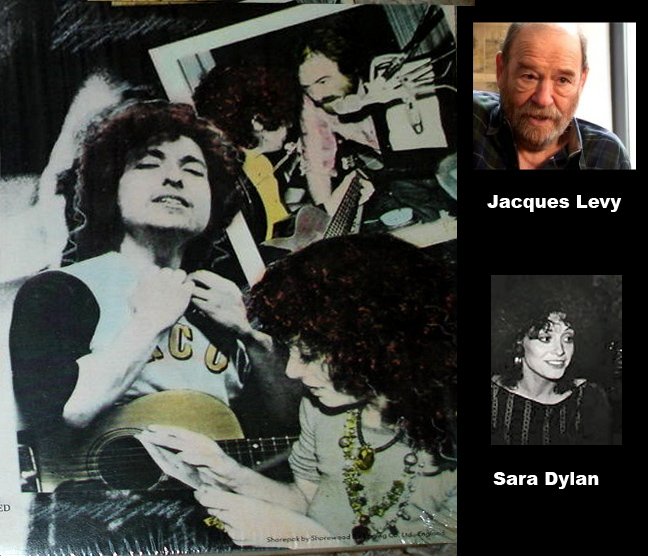
Here's Dylan wearing that same jersey. He's in a recording session for Desire on July 28th, 1975 with Eric Clapton and Emmylou Harris. Clapton can be heard playing dobro on the song Romance in Durango, but only attended one of the Desire sessions. Dylan started with many musicians at his early recording sessions for the album, then whittled it down to a core group, most of whom ended up going on the Rolling Thunder Tour with him. 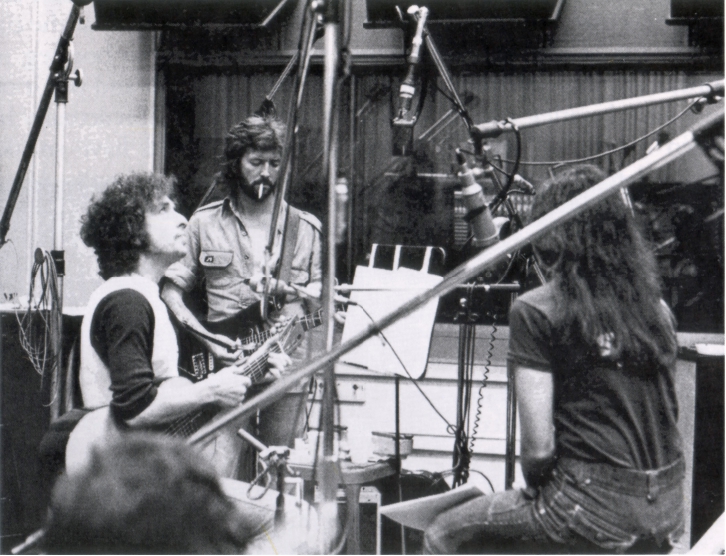
Another section of the back cover, with the producer and two of the musicians on the album and the tour. 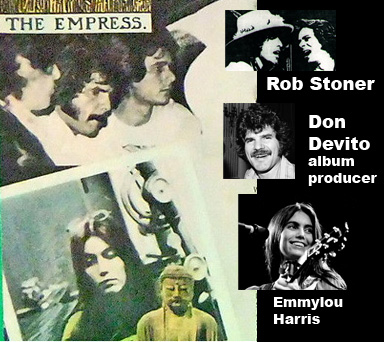
And in the top left: Scarlett and Howie. 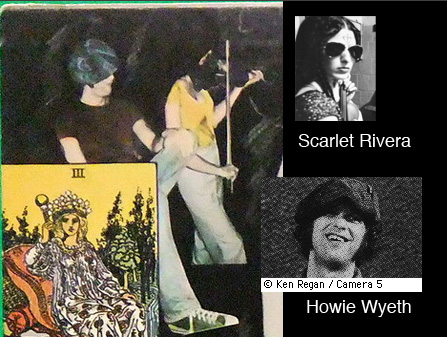
And in the top right: Joseph Conrad, the novelist, and most likely, Don Devito talking to either David Bell, who plays bellzouki on the album, or David Mansfield, who played steel guitar on the Rolling Thunder tour. Why Joseph Conrad? His novel Victory (1915) was a major influence on the song Black Diamond Bay. You can read more about that below the photo. 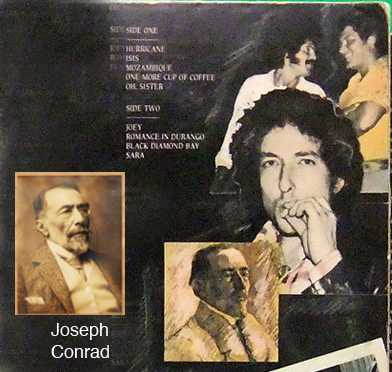
From the Wikipedia entry on Desire. 
Here's Dylan supposedly listening to a playback of one of the songs from Desire from a bootleg album. 
In this stream-of-consciousness paragraph from the inner album cover, Dylan writes about landing next to Plymouth Rock, as we saw earlier. 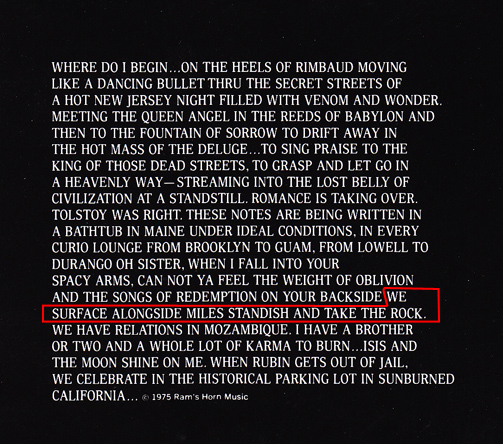
The Empress is a tarot card on the back sleeve. Many websites can give you the meaning(s) of this card in the tarot world. In short, she's the mother of fertility. In Larry Sloman's book on the Rolling Thunder Tour, On the Road with Bob Dylan, on page 357 he interviews Sara Dylan in her hotel room. Among the items he describes seeing on her bureau is "a huge tarot card of the Empress." Sloman goes on to say the card represent Doom, but the Wikipedia entry says its represent Fertility and positive things. But it also says, "The Empress may also represent the Object of Desire." Hmmm...where have we heard that word before? On, that's right, it's the name of the album! 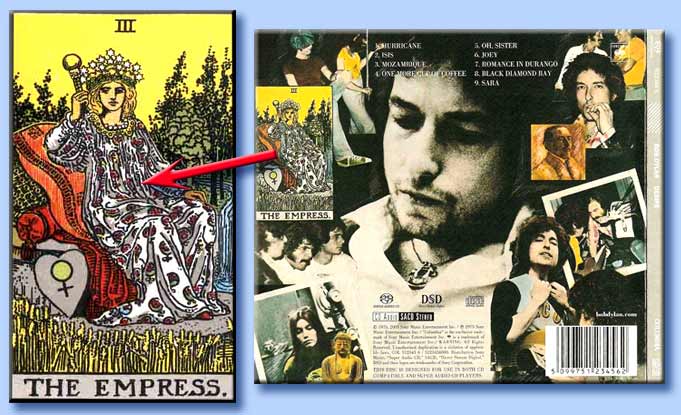

|
||

